EXHIBIT 99.1
Published on November 8, 2011
Exhibit 99.1

| 2011 Fourth Quarter Investor Handout November 7, 2011 1 |
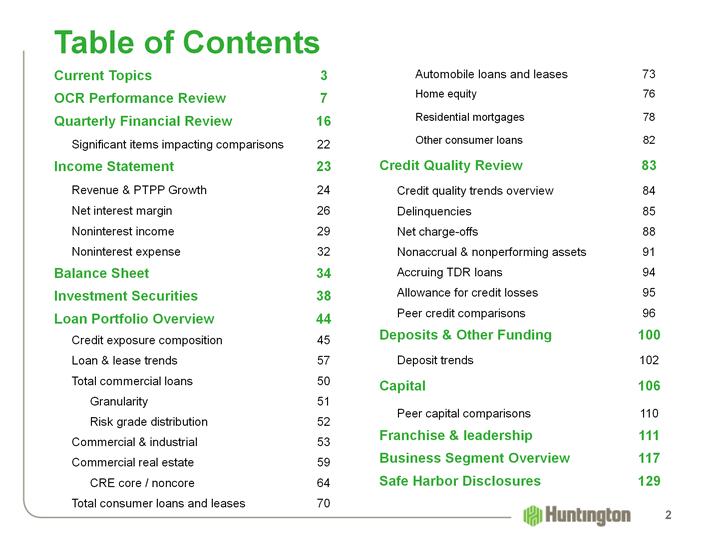
| Table of Contents Current Topics 3 OCR Performance Review 7 Quarterly Financial Review 16 Significant items impacting comparisons 22 Income Statement 23 Revenue & PTPP Growth 24 Net interest margin 26 Noninterest income 29 Noninterest expense 32 Balance Sheet 34 Investment Securities 38 Loan Portfolio Overview 44 Credit exposure composition 45 Loan & lease trends 57 Total commercial loans 50 Granularity 51 Risk grade distribution 52 Commercial & industrial 53 Commercial real estate 59 CRE core / noncore 64 Total consumer loans and leases 70 Automobile loans and leases 73 Home equity 76 Residential mortgages 78 Other consumer loans 82 Credit Quality Review 83 Credit quality trends overview 84 Delinquencies 85 Net charge-offs 88 Nonaccrual & nonperforming assets 91 Accruing TDR loans 94 Allowance for credit losses 95 Peer credit comparisons 96 Deposits & Other Funding 100 Deposit trends 102 Capital 106 Peer capital comparisons 110 Franchise & leadership 111 Business Segment Overview 117 Safe Harbor Disclosures 129 2 |
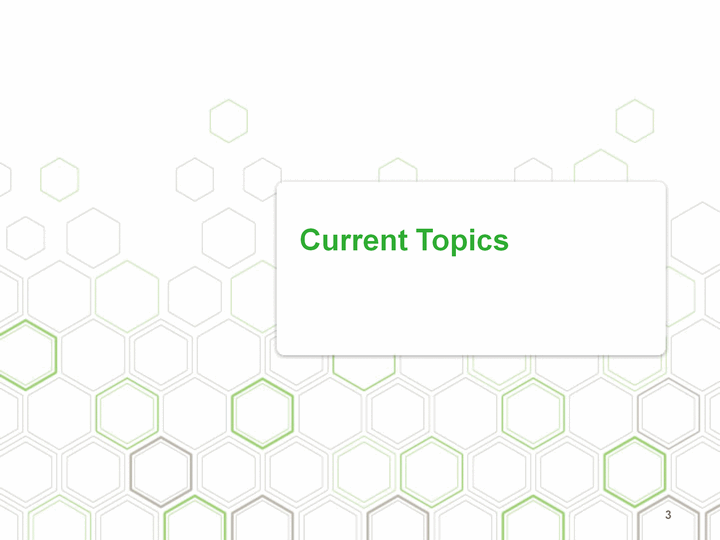
| Current Topics 3 |

| Current Topics Strategic Plan Review OCR / "Fair Play" Progress Report 4 |
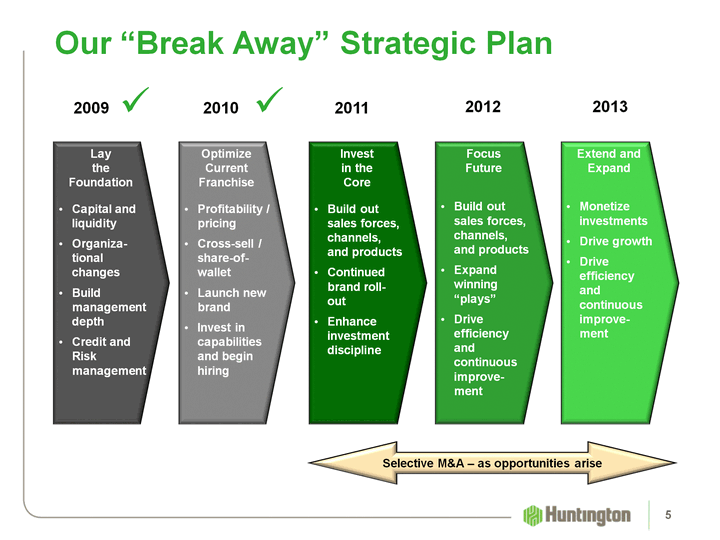
| Optimize Current Franchise Profitability / pricing Cross-sell / share-of- wallet Launch new brand Invest in capabilities and begin hiring Our "Break Away" Strategic Plan Lay the Foundation Capital and liquidity Organiza- tional changes Build management depth Credit and Risk management Invest in the Core Build out sales forces, channels, and products Continued brand roll- out Enhance investment discipline Selective M&A - as opportunities arise 2009 Focus Future Build out sales forces, channels, and products Expand winning "plays" Drive efficiency and continuous improve- ment Extend and Expand Monetize investments Drive growth Drive efficiency and continuous improve- ment 2010 2011 2012 2013 5 |
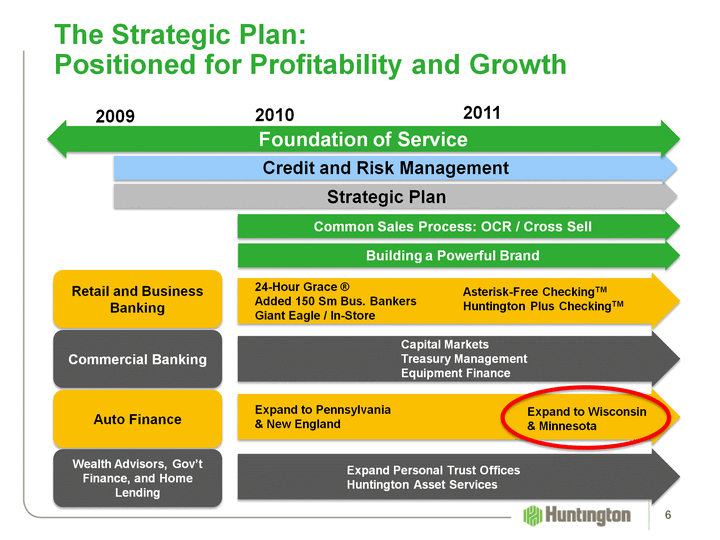
| The Strategic Plan: Positioned for Profitability and Growth 6 Retail and Business Banking Commercial Banking Auto Finance Wealth Advisors, Gov't Finance, and Home Lending 2010 2009 Credit and Risk Management Strategic Plan 24-Hour Grace (r) Added 150 Sm Bus. Bankers Giant Eagle / In-Store Asterisk-Free CheckingTM Huntington Plus CheckingTM Capital Markets Treasury Management Equipment Finance Expand to Pennsylvania & New England Expand Personal Trust Offices Huntington Asset Services Foundation of Service Common Sales Process: OCR / Cross Sell Building a Powerful Brand 2011 Expand to Wisconsin & Minnesota |
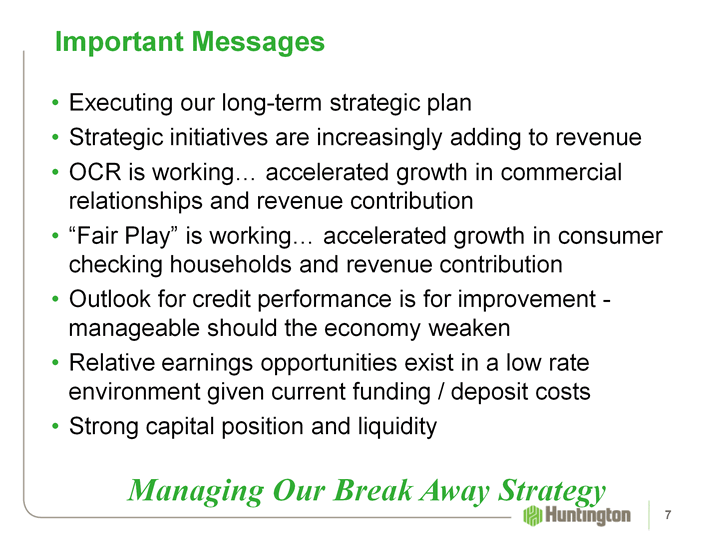
| Important Messages Executing our long-term strategic plan Strategic initiatives are increasingly adding to revenue OCR is working... accelerated growth in commercial relationships and revenue contribution "Fair Play" is working... accelerated growth in consumer checking households and revenue contribution Outlook for credit performance is for improvement - manageable should the economy weaken Relative earnings opportunities exist in a low rate environment given current funding / deposit costs Strong capital position and liquidity Managing Our Break Away Strategy 7 |
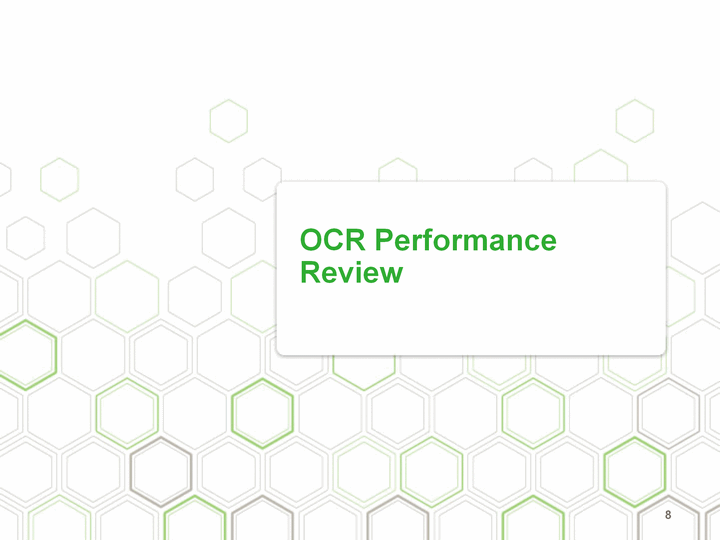
| OCR Performance Review 8 |
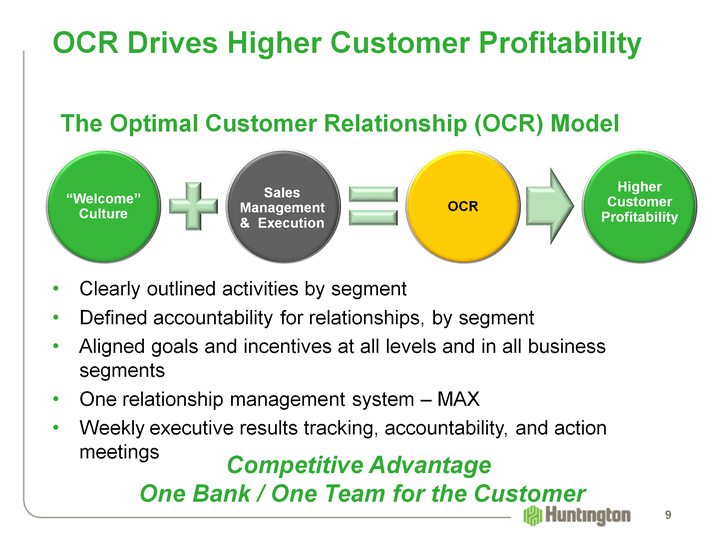
| OCR Drives Higher Customer Profitability Clearly outlined activities by segment Defined accountability for relationships, by segment Aligned goals and incentives at all levels and in all business segments One relationship management system - MAX Weekly executive results tracking, accountability, and action meetings Competitive Advantage One Bank / One Team for the Customer The Optimal Customer Relationship (OCR) Model "Welcome" Culture Sales Management & Execution OCR Higher Customer Profitability 9 |
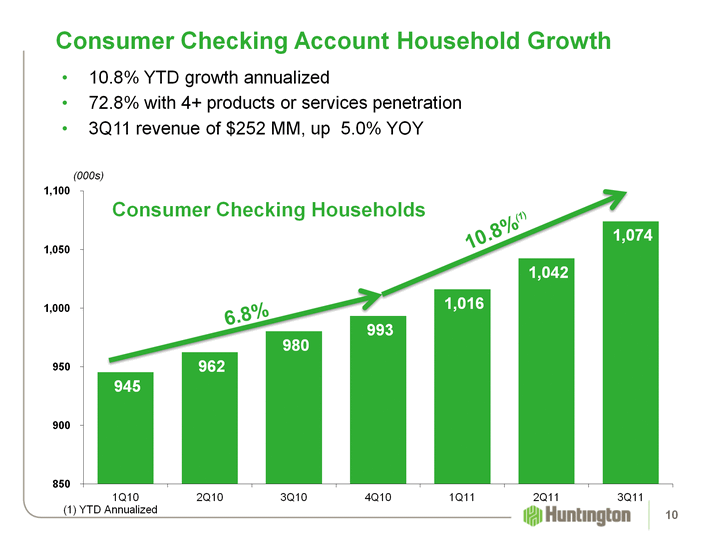
| (CHART) Consumer Checking Account Household Growth Consumer Checking Households 6.8% 10.8%(1) (1) YTD Annualized 10.8% YTD growth annualized 72.8% with 4+ products or services penetration 3Q11 revenue of $252 MM, up 5.0% YOY (000s) 10 |
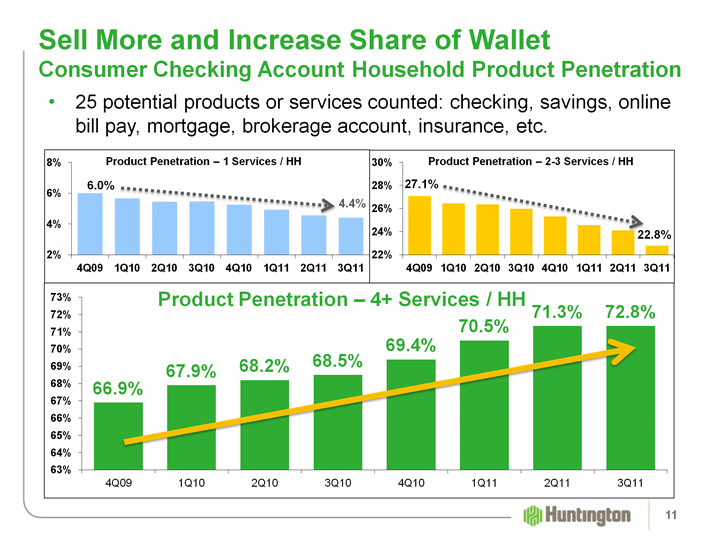
| (CHART) Sell More and Increase Share of Wallet Consumer Checking Account Household Product Penetration Product Penetration - 4+ Services / HH 25 potential products or services counted: checking, savings, online bill pay, mortgage, brokerage account, insurance, etc. (CHART) (CHART) Product Penetration - 1 Services / HH Product Penetration - 2-3 Services / HH 11 |
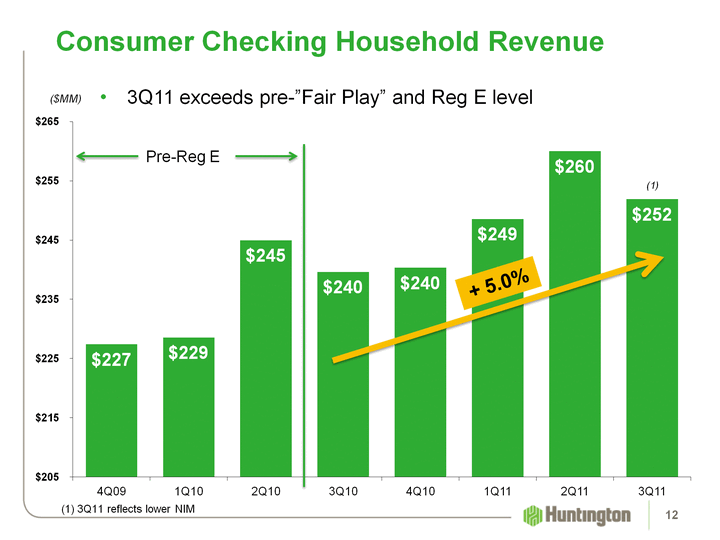
| (CHART) Consumer Checking Household Revenue + 5.0% ($MM) 3Q11 exceeds pre-"Fair Play" and Reg E level 12 Pre-Reg E (1) 3Q11 reflects lower NIM (1) |
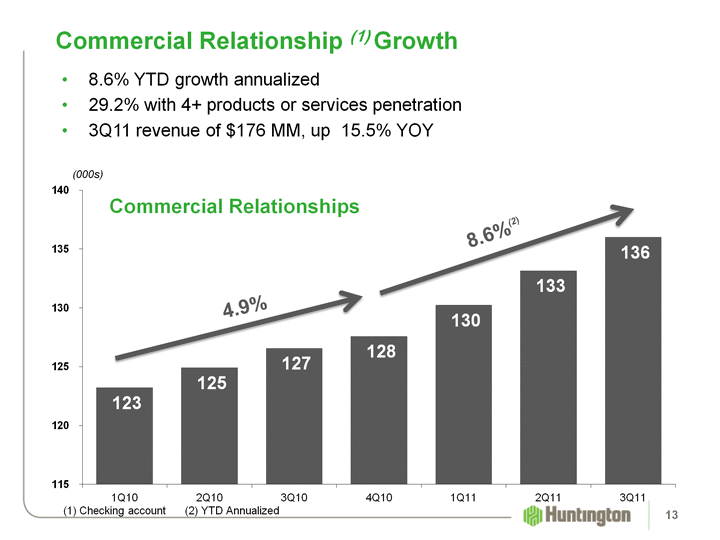
| (CHART) Commercial Relationships 4.9% 8.6%(2) (1) Checking account (2) YTD Annualized 8.6% YTD growth annualized 29.2% with 4+ products or services penetration 3Q11 revenue of $176 MM, up 15.5% YOY (000s) 13 Commercial Relationship (1) Growth |
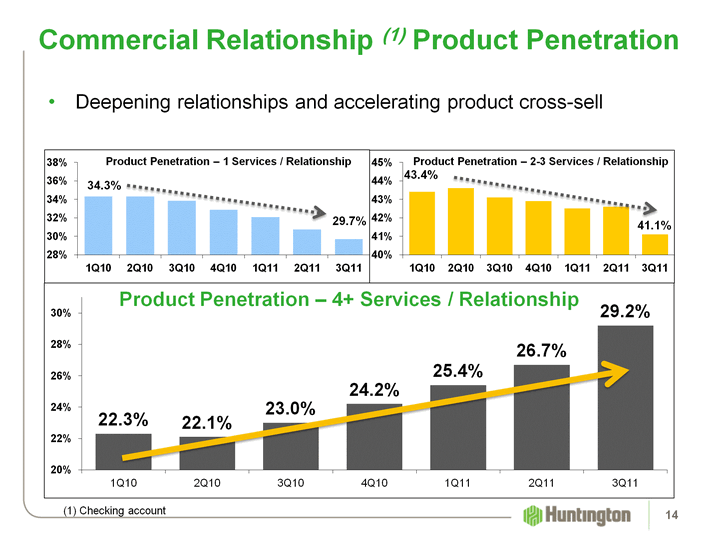
| (CHART) Commercial Relationship (1) Product Penetration Product Penetration - 4+ Services / Relationship Deepening relationships and accelerating product cross-sell (CHART) (CHART) Product Penetration - 1 Services / Relationship Product Penetration - 2-3 Services / Relationship 14 (1) Checking account |
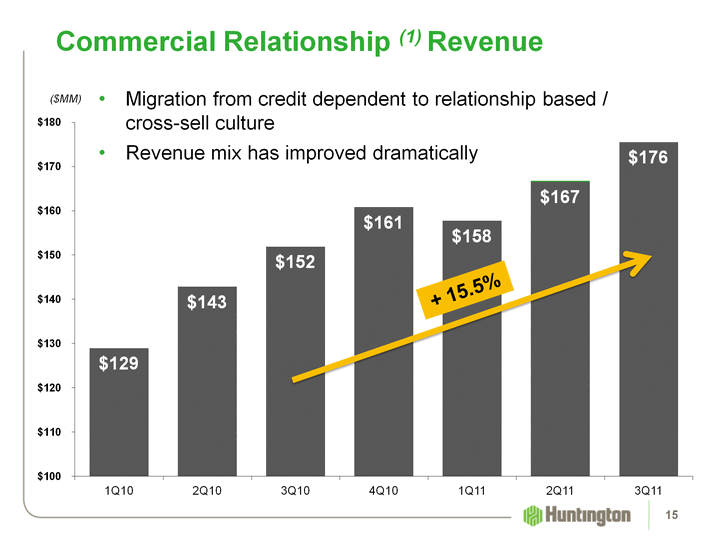
| Migration from credit dependent to relationship based / cross-sell culture Revenue mix has improved dramatically (CHART) 15 Commercial Relationship (1) Revenue ($MM) + 15.5% |
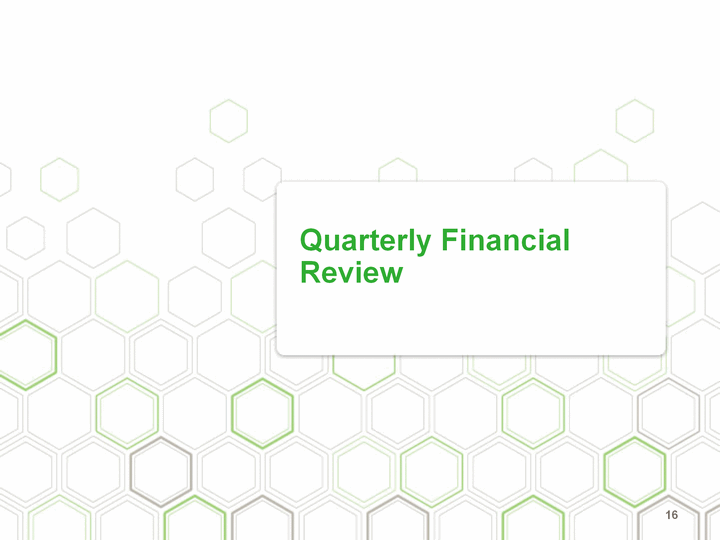
| Quarterly Financial Review 16 |
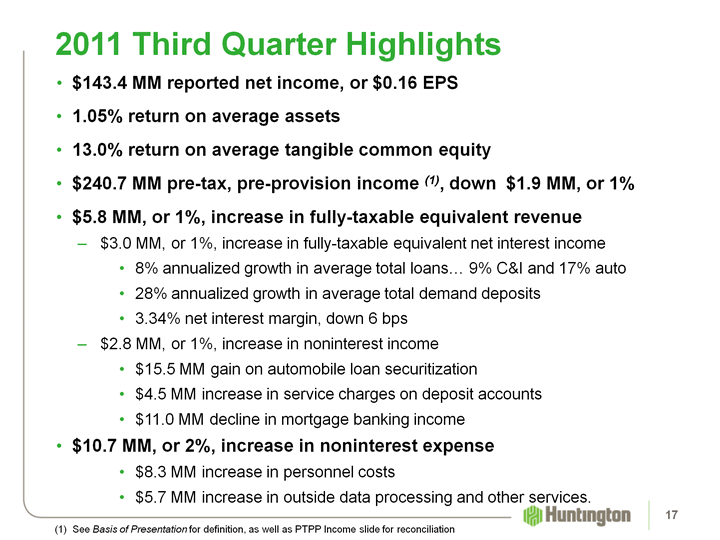
| $143.4 MM reported net income, or $0.16 EPS 1.05% return on average assets 13.0% return on average tangible common equity $240.7 MM pre-tax, pre-provision income (1), down $1.9 MM, or 1% $5.8 MM, or 1%, increase in fully-taxable equivalent revenue $3.0 MM, or 1%, increase in fully-taxable equivalent net interest income 8% annualized growth in average total loans... 9% C&I and 17% auto 28% annualized growth in average total demand deposits 3.34% net interest margin, down 6 bps $2.8 MM, or 1%, increase in noninterest income $15.5 MM gain on automobile loan securitization $4.5 MM increase in service charges on deposit accounts $11.0 MM decline in mortgage banking income $10.7 MM, or 2%, increase in noninterest expense $8.3 MM increase in personnel costs $5.7 MM increase in outside data processing and other services. 2011 Third Quarter Highlights See Basis of Presentation for definition, as well as PTPP Income slide for reconciliation 17 |
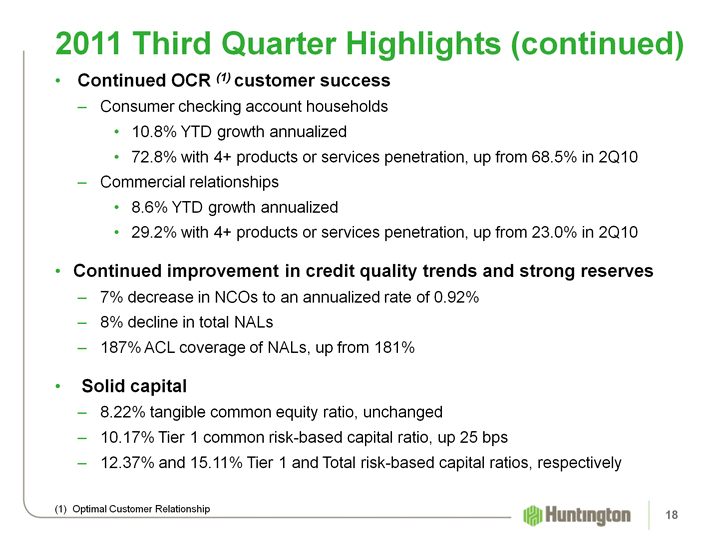
| Continued OCR (1) customer success Consumer checking account households 10.8% YTD growth annualized 72.8% with 4+ products or services penetration, up from 68.5% in 2Q10 Commercial relationships 8.6% YTD growth annualized 29.2% with 4+ products or services penetration, up from 23.0% in 2Q10 Continued improvement in credit quality trends and strong reserves 7% decrease in NCOs to an annualized rate of 0.92% 8% decline in total NALs 187% ACL coverage of NALs, up from 181% Solid capital 8.22% tangible common equity ratio, unchanged 10.17% Tier 1 common risk-based capital ratio, up 25 bps 12.37% and 15.11% Tier 1 and Total risk-based capital ratios, respectively 2011 Third Quarter Highlights (continued) Optimal Customer Relationship 18 |
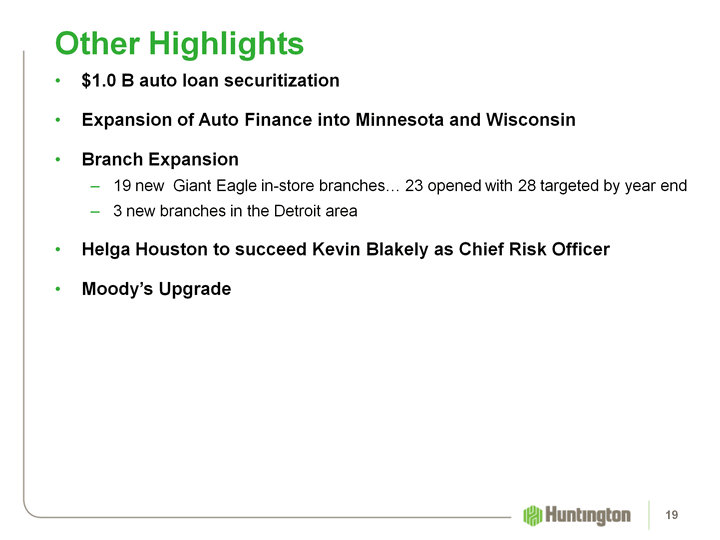
| $1.0 B auto loan securitization Expansion of Auto Finance into Minnesota and Wisconsin Branch Expansion 19 new Giant Eagle in-store branches... 23 opened with 28 targeted by year end 3 new branches in the Detroit area Helga Houston to succeed Kevin Blakely as Chief Risk Officer Moody's Upgrade Other Highlights 19 |
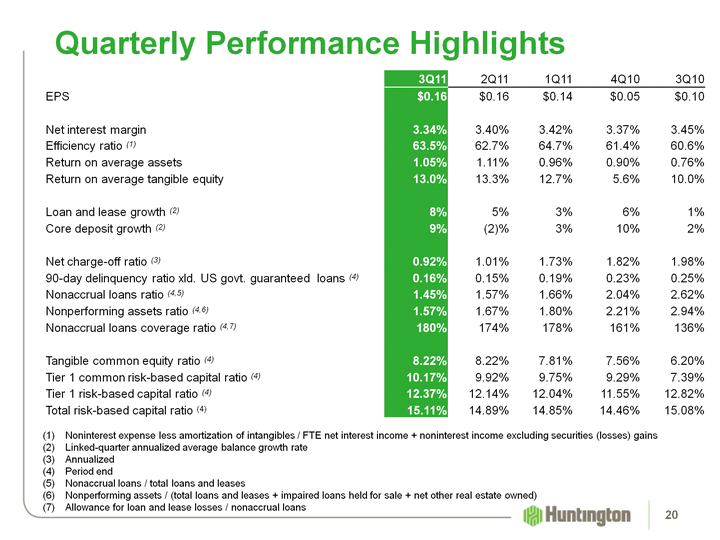
| Quarterly Performance Highlights 3Q11 2Q11 1Q11 4Q10 3Q10 EPS $0.16 $0.16 $0.14 $0.05 $0.10 Net interest margin 3.34% 3.40% 3.42% 3.37% 3.45% Efficiency ratio (1) 63.5% 62.7% 64.7% 61.4% 60.6% Return on average assets 1.05% 1.11% 0.96% 0.90% 0.76% Return on average tangible equity 13.0% 13.3% 12.7% 5.6% 10.0% Loan and lease growth (2) 8% 5% 3% 6% 1% Core deposit growth (2) 9% (2)% 3% 10% 2% Net charge-off ratio (3) 0.92% 1.01% 1.73% 1.82% 1.98% 90-day delinquency ratio xld. US govt. guaranteed loans (4) 0.16% 0.15% 0.19% 0.23% 0.25% Nonaccrual loans ratio (4,5) 1.45% 1.57% 1.66% 2.04% 2.62% Nonperforming assets ratio (4,6) 1.57% 1.67% 1.80% 2.21% 2.94% Nonaccrual loans coverage ratio (4,7) 180% 174% 178% 161% 136% Tangible common equity ratio (4) 8.22% 8.22% 7.81% 7.56% 6.20% Tier 1 common risk-based capital ratio (4) 10.17% 9.92% 9.75% 9.29% 7.39% Tier 1 risk-based capital ratio (4) 12.37% 12.14% 12.04% 11.55% 12.82% Total risk-based capital ratio (4) 15.11% 14.89% 14.85% 14.46% 15.08% (1) Noninterest expense less amortization of intangibles / FTE net interest income + noninterest income excluding securities (losses) gains Linked-quarter annualized average balance growth rate Annualized Period end Nonaccrual loans / total loans and leases Nonperforming assets / (total loans and leases + impaired loans held for sale + net other real estate owned) Allowance for loan and lease losses / nonaccrual loans 20 |
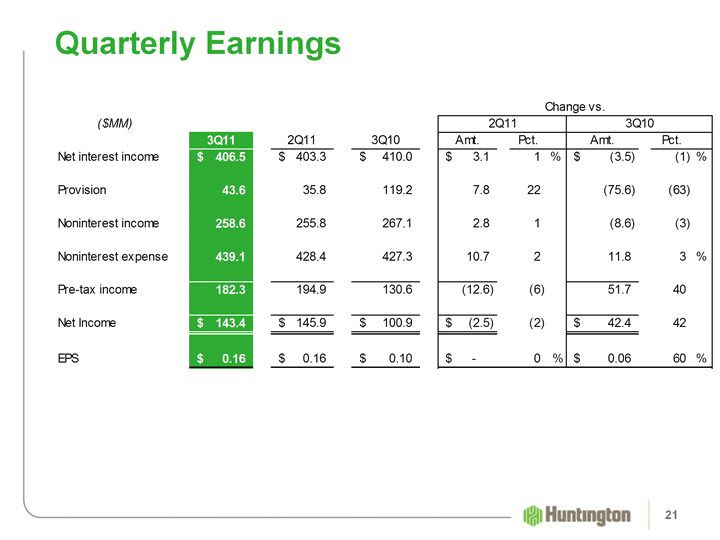
| Quarterly Earnings 21 |
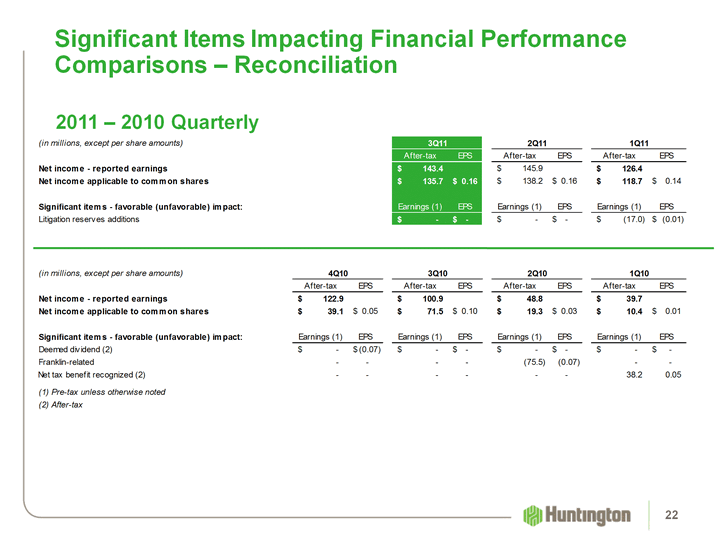
| Significant Items Impacting Financial Performance Comparisons - Reconciliation 2011 - 2010 Quarterly 22 |
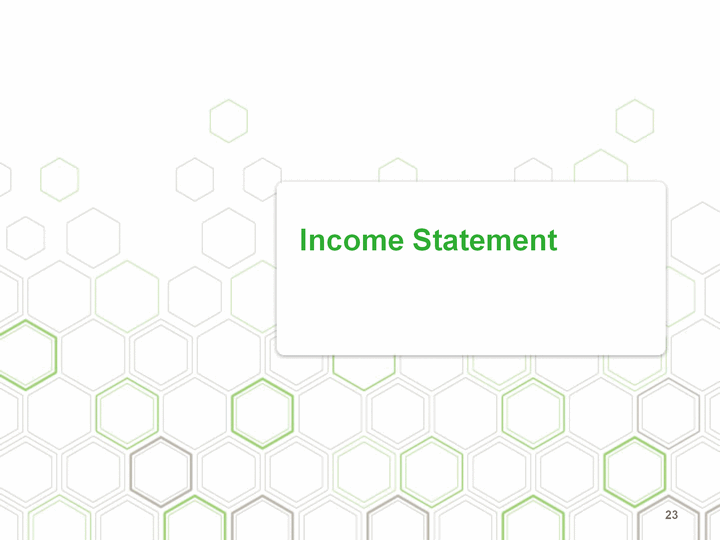
| Income Statement 23 |

| (CHART) Revenue and PTPP Growth (1) ($MM) (CHART) (1) Revenue is FTE; See Basis of Presentation for definition of PTPP, as well as PTPP Income reconciliation slide (2) Annualized PTPP Earnings Power (2) Revenue and PTPP Trends 24 |
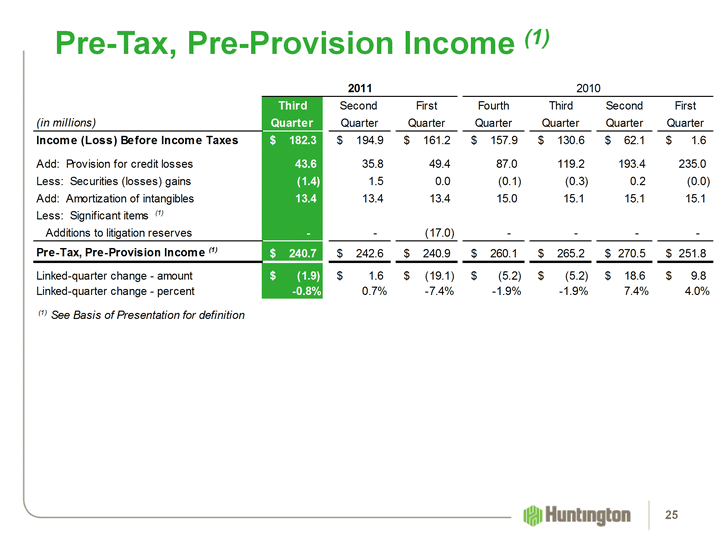
| Pre-Tax, Pre-Provision Income (1) 25 |
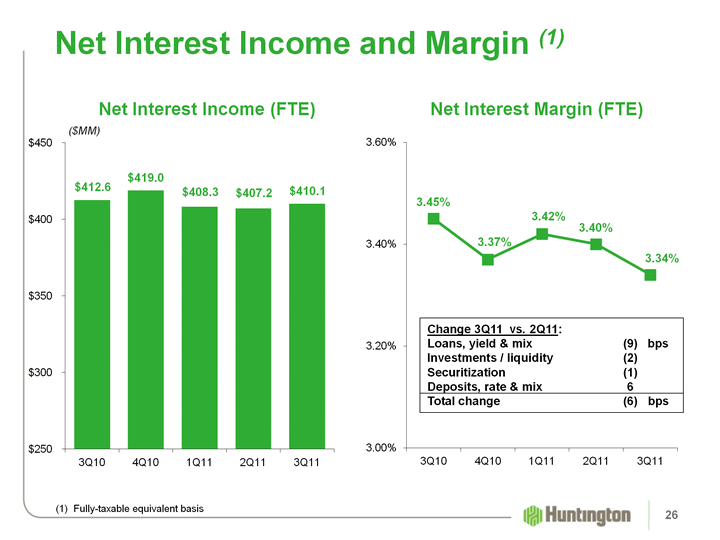
| (CHART) (CHART) Change 3Q11 vs. 2Q11: Loans, yield & mix (9) bps Investments / liquidity (2) Securitization (1) Deposits, rate & mix 6 Total change (6) bps Net Interest Income and Margin (1) ($MM) (1) Fully-taxable equivalent basis Net Interest Margin (FTE) Net Interest Income (FTE) 26 |
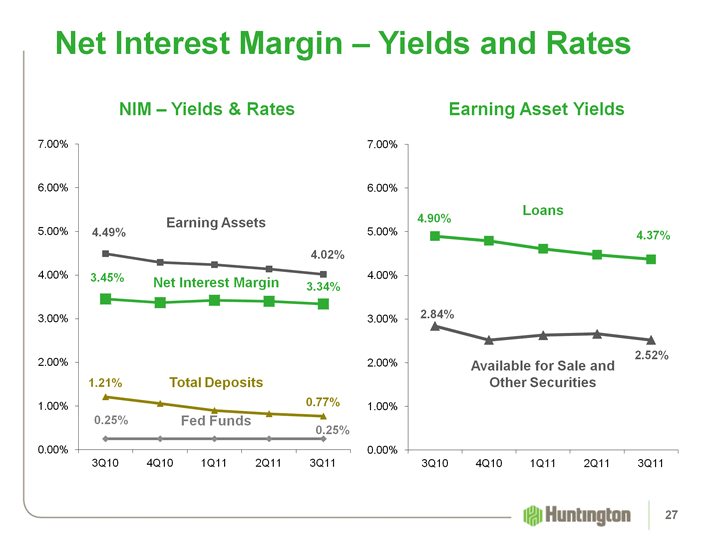
| Net Interest Margin - Yields and Rates (CHART) (CHART) Earning Assets Total Deposits Fed Funds Net Interest Margin Loans Available for Sale and Other Securities Earning Asset Yields NIM - Yields & Rates 27 |
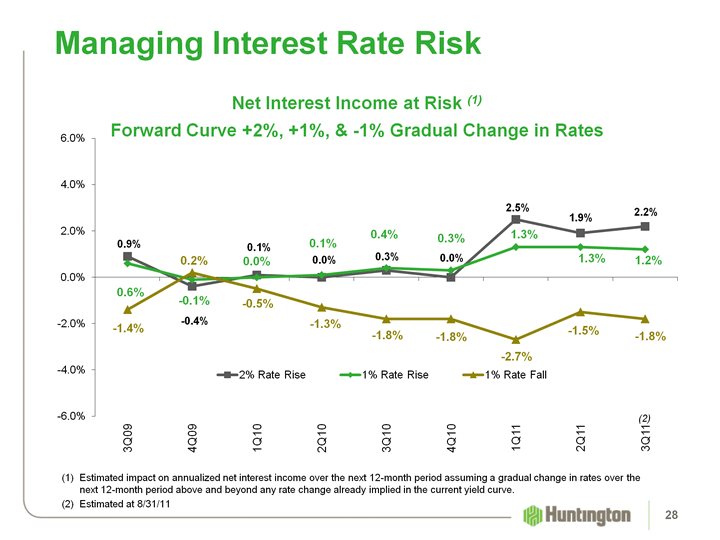
| Net Interest Income at Risk (1) Forward Curve +2%, +1%, & -1% Gradual Change in Rates (CHART) Managing Interest Rate Risk Estimated impact on annualized net interest income over the next 12-month period assuming a gradual change in rates over the next 12-month period above and beyond any rate change already implied in the current yield curve. Estimated at 8/31/11 (2) 28 |

| Noninterest Income Trends Linked Quarter 29 |
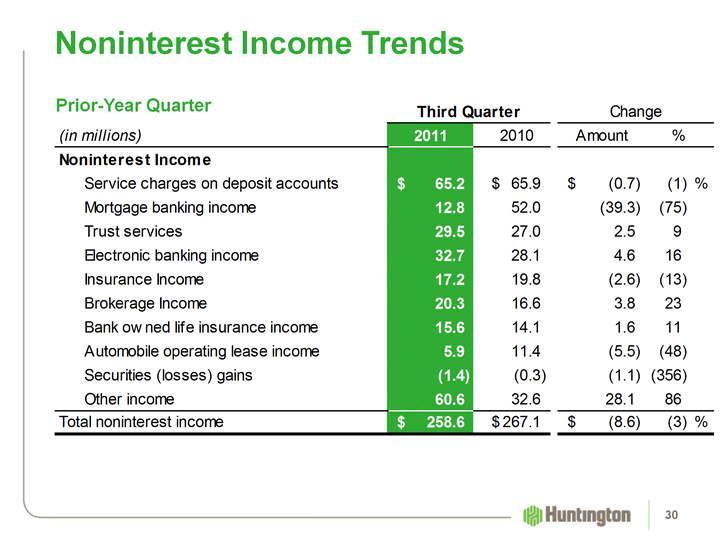
| Noninterest Income Trends Prior-Year Quarter 30 |
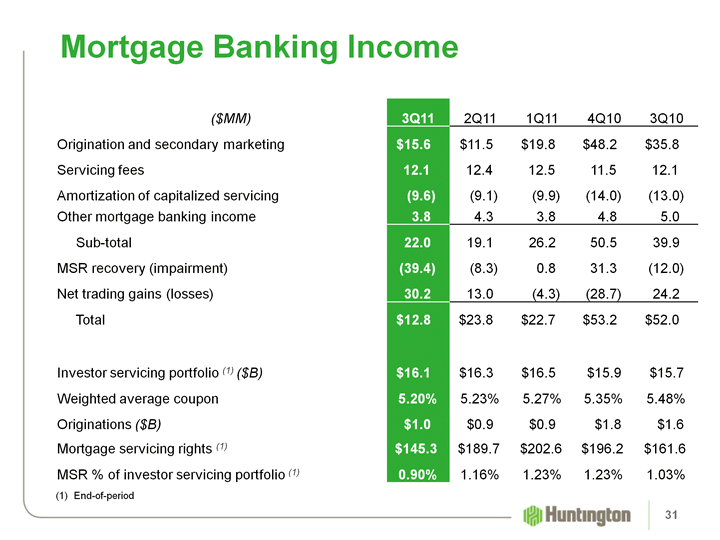
| Mortgage Banking Income ($MM) 3Q11 2Q11 1Q11 4Q10 3Q10 Origination and secondary marketing $15.6 $11.5 $19.8 $48.2 $35.8 Servicing fees 12.1 12.4 12.5 11.5 12.1 Amortization of capitalized servicing (9.6) (9.1) (9.9) (14.0) (13.0) Other mortgage banking income 3.8 4.3 3.8 4.8 5.0 Sub-total 22.0 19.1 26.2 50.5 39.9 MSR recovery (impairment) (39.4) (8.3) 0.8 31.3 (12.0) Net trading gains (losses) 30.2 13.0 (4.3) (28.7) 24.2 Total $12.8 $23.8 $22.7 $53.2 $52.0 Investor servicing portfolio (1) ($B) $16.1 $16.3 $16.5 $15.9 $15.7 Weighted average coupon 5.20% 5.23% 5.27% 5.35% 5.48% Originations ($B) $1.0 $0.9 $0.9 $1.8 $1.6 Mortgage servicing rights (1) $145.3 $189.7 $202.6 $196.2 $161.6 MSR % of investor servicing portfolio (1) 0.90% 1.16% 1.23% 1.23% 1.03% (1) End-of-period 31 |
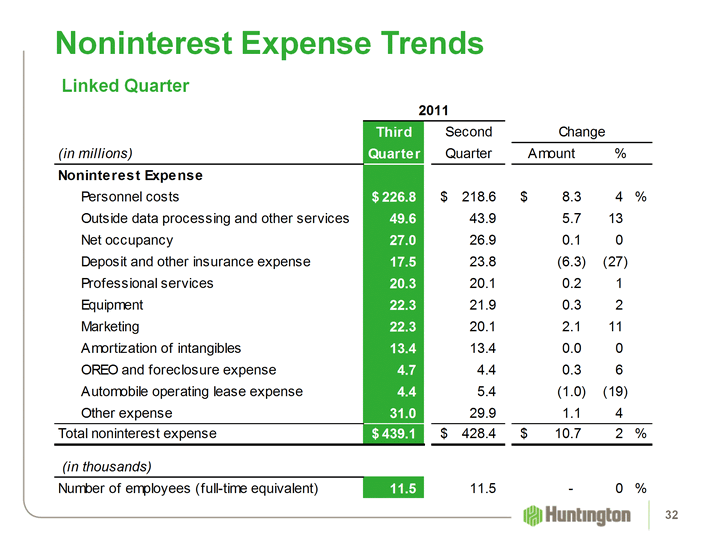
| Noninterest Expense Trends Linked Quarter 32 |
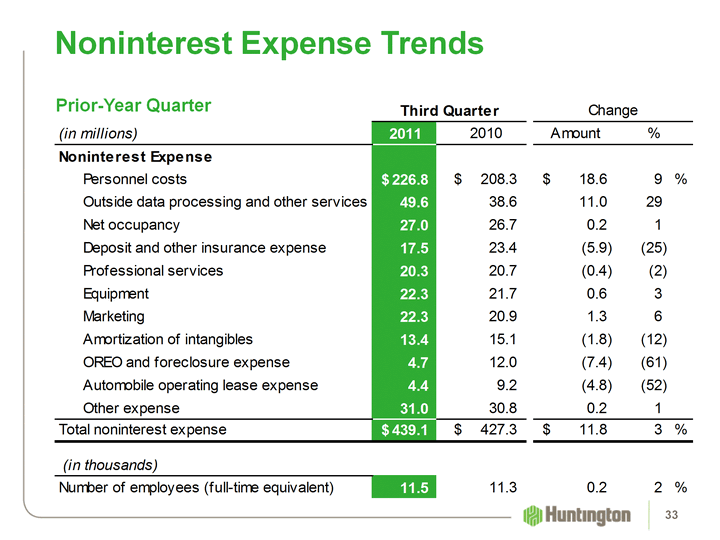
| Noninterest Expense Trends Prior-Year Quarter 33 |
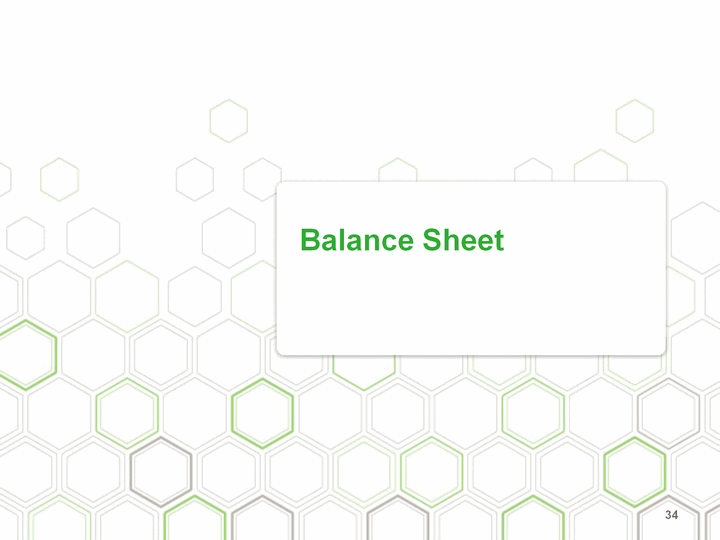
| Balance Sheet 34 |

| Balance Sheet - Assets 35 |

| Balance Sheet - Liabilities and Shareholders' Equity 36 |
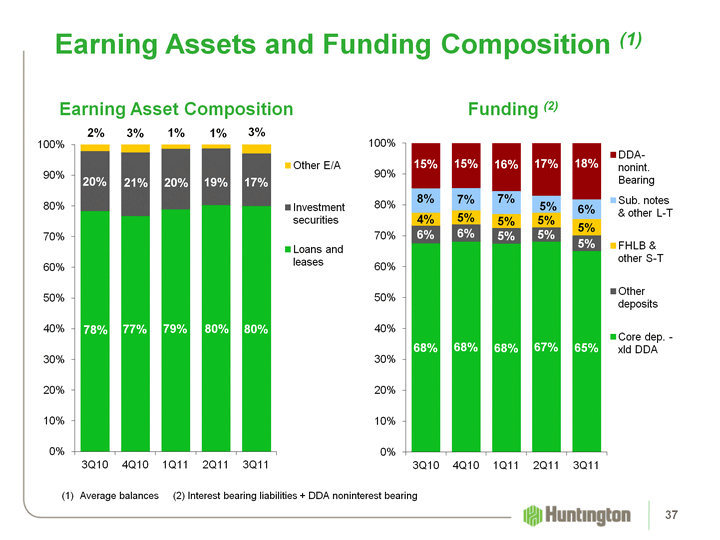
| Earning Assets and Funding Composition (1) (CHART) (1) Average balances (2) Interest bearing liabilities + DDA noninterest bearing (CHART) Funding (2) Earning Asset Composition 37 |
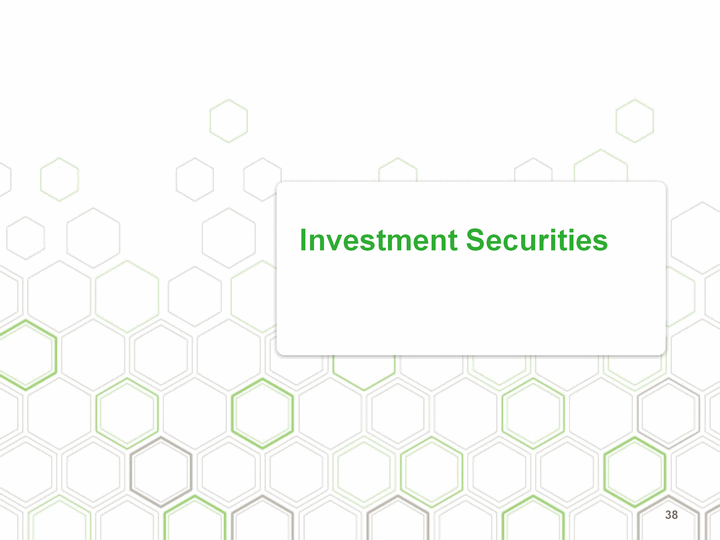
| Investment Securities 38 |
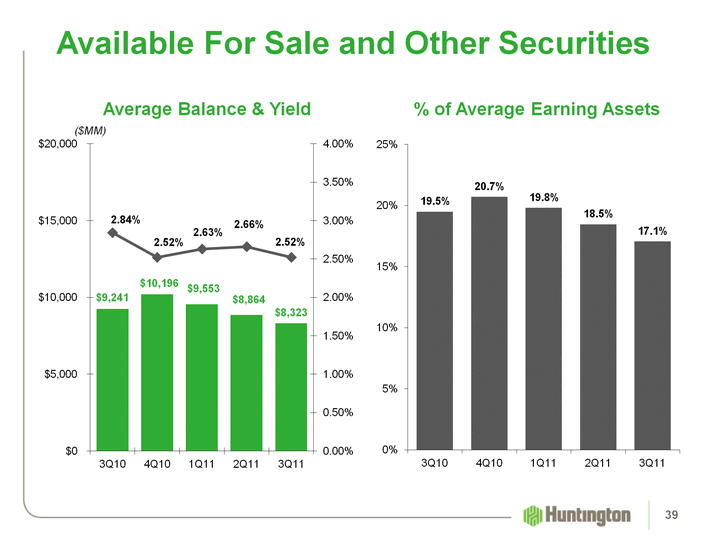
| (CHART) (CHART) Available For Sale and Other Securities ($MM) % of Average Earning Assets Average Balance & Yield 39 |

| Securities Trends (1) Linked Quarter - Average Treasury/Agency debt with weighted average life of approximately 2.9 years Agency mortgages with weighted average life of approximately 3.1 years 40 |
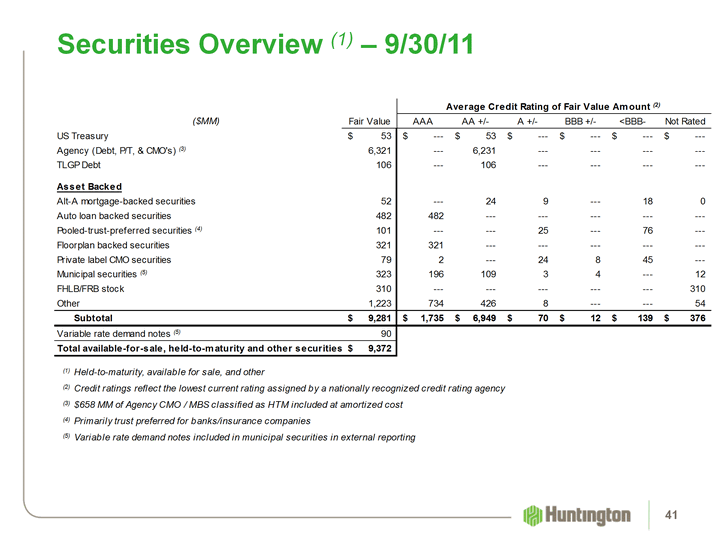
| Securities Overview (1) - 9/30/11 41 |
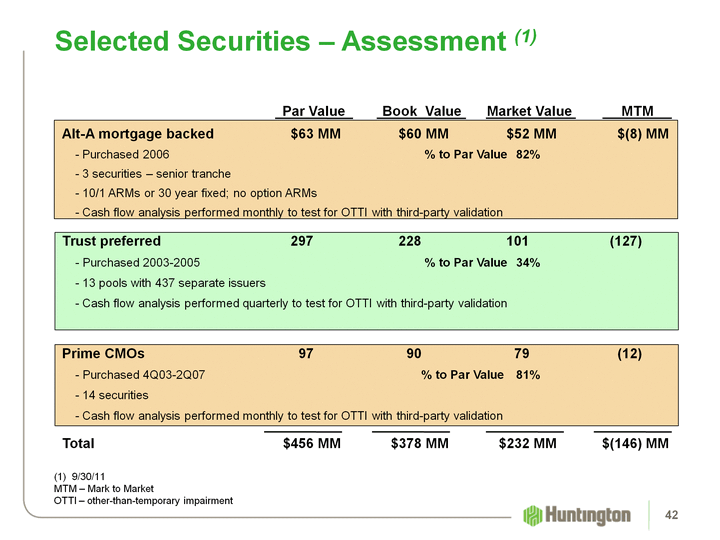
| Selected Securities - Assessment (1) Par Value Book Value Market Value MTM Alt-A mortgage backed $63 MM $60 MM $52 MM $(8) MM - Purchased 2006 % to Par Value 82% - 3 securities - senior tranche - 10/1 ARMs or 30 year fixed; no option ARMs - Cash flow analysis performed monthly to test for OTTI with third-party validation Trust preferred 297 228 101 (127) - Purchased 2003-2005 % to Par Value 34% - 13 pools with 437 separate issuers - Cash flow analysis performed quarterly to test for OTTI with third-party validation Prime CMOs 97 90 79 (12) - Purchased 4Q03-2Q07 % to Par Value 81% - 14 securities - Cash flow analysis performed monthly to test for OTTI with third-party validation Total $456 MM $378 MM $232 MM $(146) MM 9/30/11 MTM - Mark to Market OTTI - other-than-temporary impairment 42 |
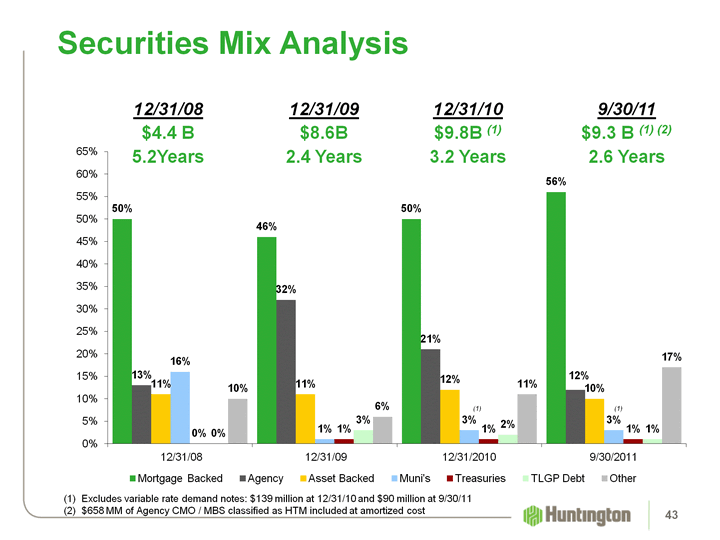
| (CHART) Securities Mix Analysis 12/31/10 $9.8B (1) 3.2 Years 12/31/08 $4.4 B 5.2Years 12/31/09 $8.6B 2.4 Years Excludes variable rate demand notes: $139 million at 12/31/10 and $90 million at 9/30/11 $658 MM of Agency CMO / MBS classified as HTM included at amortized cost (1) 9/30/11 $9.3 B (1) (2) 2.6 Years 43 (1) |
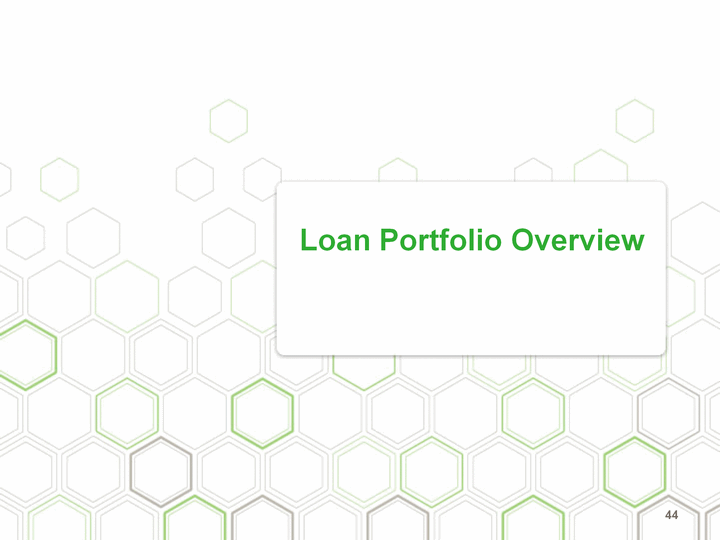
| Loan Portfolio Overview 44 |
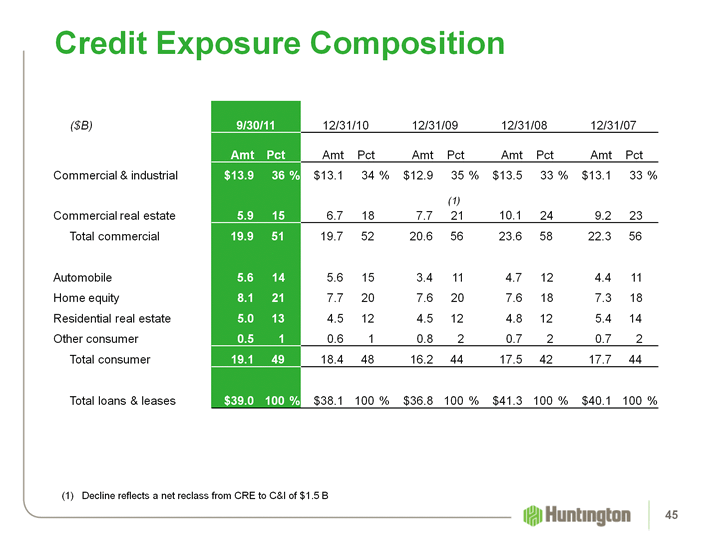
| ($B) 9/30/11 9/30/11 9/30/11 12/31/10 12/31/10 12/31/10 12/31/09 12/31/09 12/31/09 12/31/08 12/31/08 12/31/08 12/31/07 12/31/07 12/31/07 Amt Pct Amt Pct Amt Pct Amt Pct Amt Pct Commercial & industrial $13.9 36 % $13.1 34 % $12.9 35 % $13.5 33 % $13.1 33 % Commercial real estate 5.9 15 6.7 18 7.7 21 10.1 24 9.2 23 Total commercial 19.9 51 19.7 52 20.6 56 23.6 58 22.3 56 Automobile 5.6 14 5.6 15 3.4 11 4.7 12 4.4 11 Home equity 8.1 21 7.7 20 7.6 20 7.6 18 7.3 18 Residential real estate 5.0 13 4.5 12 4.5 12 4.8 12 5.4 14 Other consumer 0.5 1 0.6 1 0.8 2 0.7 2 0.7 2 Total consumer 19.1 49 18.4 48 16.2 44 17.5 42 17.7 44 Total loans & leases $39.0 100 % $38.1 100 % $36.8 100 % $41.3 100 % $40.1 100 % Credit Exposure Composition (1) Decline reflects a net reclass from CRE to C&I of $1.5 B (1) 45 |

| (CHART) Total Loans and Leases Portfolio Overview ($B) $20.1 $6.2 $2.9 $1.4 $2.8 $1.4 $0.8 $3.5 EOP Outstandings - $39.0 Billion (1) (1) 9/30/11 By State 46 |

| Loan and Lease Trends Linked Quarter 47 |
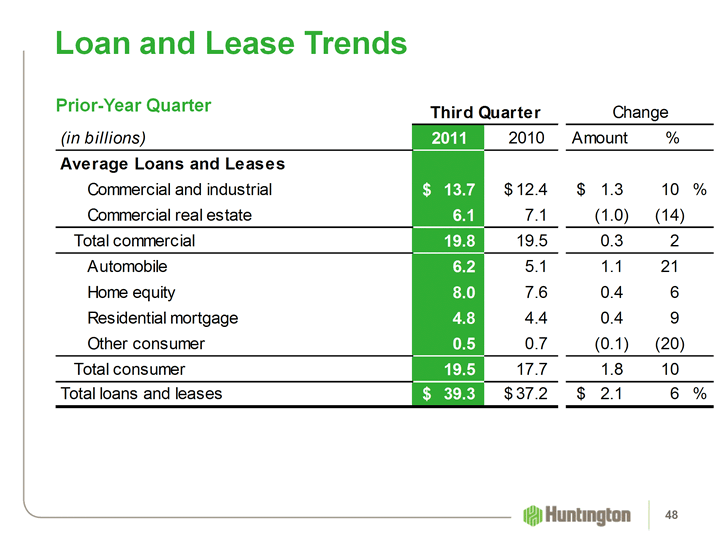
| Loan and Lease Trends 48 Prior-Year Quarter |
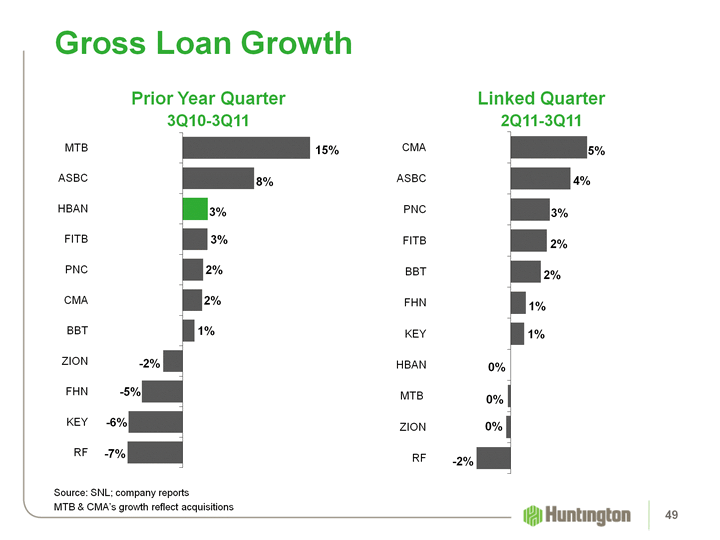
| Gross Loan Growth (CHART) (CHART) Source: SNL; company reports MTB & CMA's growth reflect acquisitions Prior Year Quarter 3Q10-3Q11 Linked Quarter 2Q11-3Q11 49 |

| Total Commercial Loans 50 |
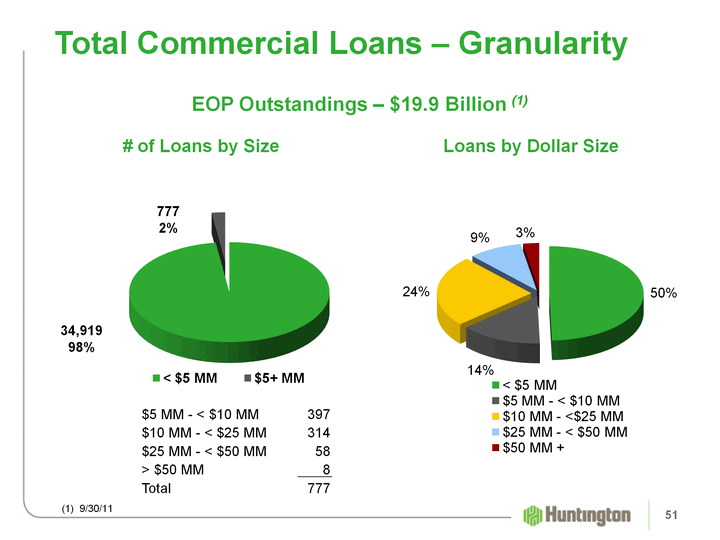
| (CHART) Total Commercial Loans - Granularity EOP Outstandings - $19.9 Billion (1) (CHART) 777 2% 34,919 98% (1) 9/30/11 Loans by Dollar Size # of Loans by Size $5 MM - < $10 MM 397 $10 MM - < $25 MM 314 $25 MM - < $50 MM 58 > $50 MM 8 Total 777 51 |
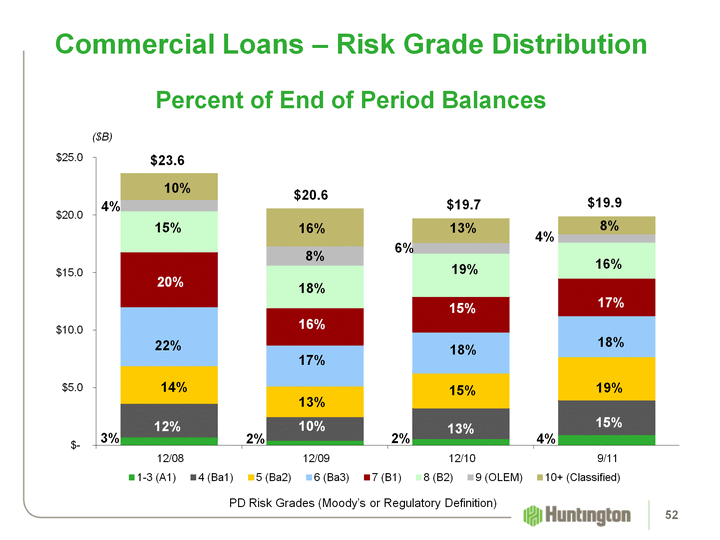
| (CHART) Commercial Loans - Risk Grade Distribution PD Risk Grades (Moody's or Regulatory Definition) Percent of End of Period Balances ($B) $23.6 $20.6 15% 16% 10% 8% 4% 18% 16% 20% 17% 22% 13% 14% 10% 12% 2% 3% 13% 6% 19% 15% 18% 15% 13% 2% $19.7 15% 8% 4% 16% 17% 18% 19% 15% 4% $19.9 52 |
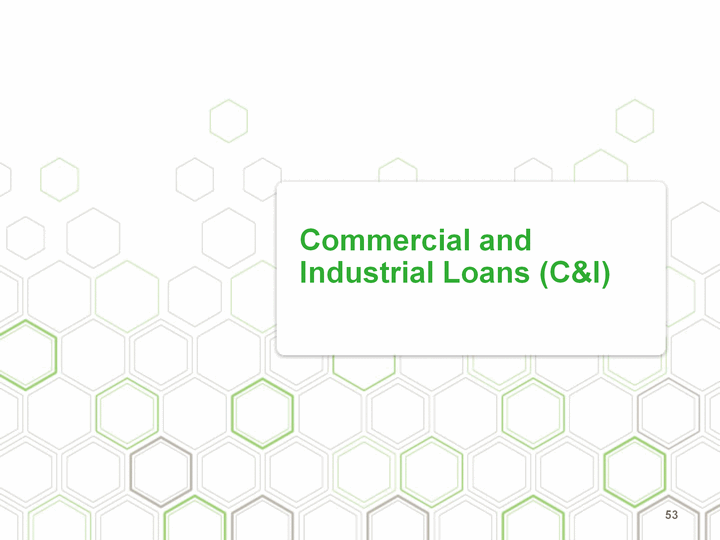
| Commercial and Industrial Loans (C&I) 53 |

| C&I - Overview EOP Outstandings - $13.9 Billion (1) Diversified by sector and geographically within our Midwest footprint Granular 7 loans >$50 million... 4% of portfolio 65 loans $20-$50 million... 13% of the portfolio Focus on middle market companies with $15-$500 million in sales Credit Quality Trends (1) 9/30/11 (2) End of Period (3) Annualized 3Q11 2Q11 1Q11 4Q10 3Q10 30+ days PD & accruing (2) 0.27% 0.27% 0.37% 0.33% 0.97% 90+ days PD & accruing (2) -- -- -- -- -- NCOs (3) 0.52% 0.56% 1.29% 1.85% 2.01% NALs (2) 1.50% 1.69% 1.96% 2.65% 3.21% ACL (1) 2.26% 2.31% 2.48% 2.86% 3.07% 54 |
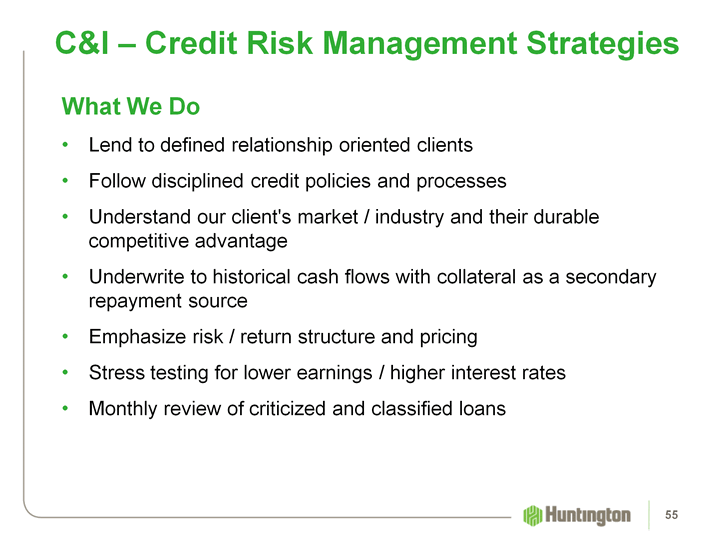
| C&I - Credit Risk Management Strategies What We Do Lend to defined relationship oriented clients Follow disciplined credit policies and processes Understand our client's market / industry and their durable competitive advantage Underwrite to historical cash flows with collateral as a secondary repayment source Emphasize risk / return structure and pricing Stress testing for lower earnings / higher interest rates Monthly review of criticized and classified loans 55 |
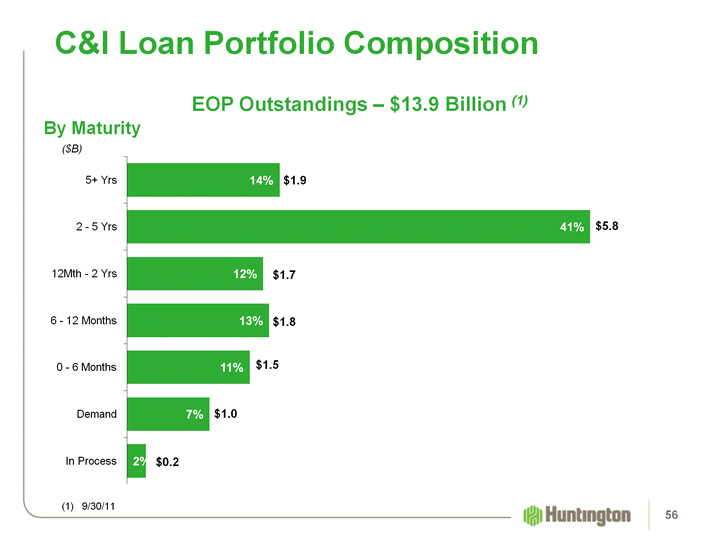
| (CHART) C&I Loan Portfolio Composition ($B) EOP Outstandings - $13.9 Billion (1) (1) 9/30/11 By Maturity $1.9 $5.8 $1.7 $1.8 $1.5 $1.0 $0.2 56 |
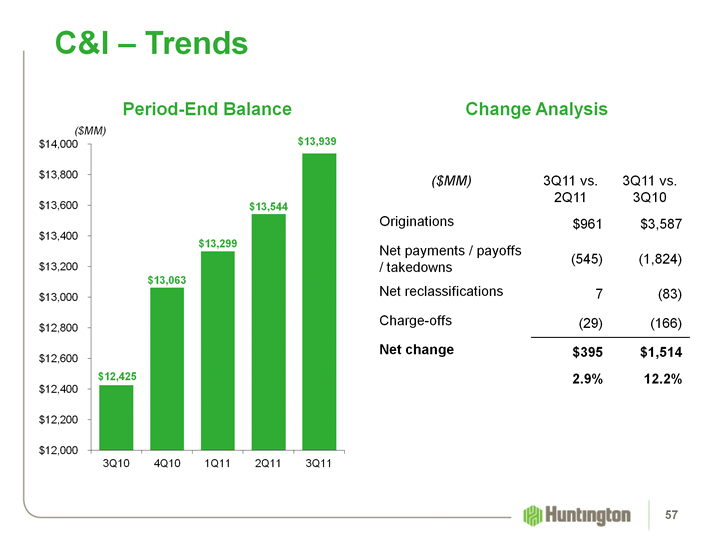
| (CHART) C&I - Trends ($MM) Change Analysis Period-End Balance ($MM) 3Q11 vs. 2Q11 3Q11 vs. 3Q10 Originations $961 $3,587 Net payments / payoffs / takedowns (545) (1,824) Net reclassifications 7 (83) Charge-offs (29) (166) Net change $395 $1,514 2.9% 12.2% 57 |

| C&I - Auto Industry (1) Outstandings (2) ($MM) 3Q11 2Q11 1Q11 4Q10 3Q10 Suppliers Domestic $ 126 $ 127 $ 135 $ 127 $ 135 Foreign 20 20 23 22 22 Total suppliers 146 146 157 149 157 Dealers Floorplan-domestic 625 651 620 599 470 Floorplan-foreign 289 329 463 457 302 Total floorplan 913 980 1083 1056 772 Other 389 395 391 373 363 Total dealers 1,302 1,375 1,474 1,429 1,135 Total auto industry $1,448 $1,521 $1,631 $1,578 $1,292 NALs Suppliers 1.98 % 2.16 % 3.90 % 5.31 % 5.82 % Dealers 0.06 0.07 0.06 0.07 0.09 Net charge-offs (3) Suppliers 0.20 % 0.63 % 0.25 %% 2.54 % 1.19 % Dealers 0.0 0.0 0.0 0.0 0.0 (1) End of period (2) Companies with > 25% of their revenue from the auto industry (3) Annualized 58 |

| Commercial Real Estate Loans (CRE) 59 |

| CRE - Overview EOP Outstandings - $5.9 Billion (1) Granular portfolio with geographic and project diversification throughout our footprint Construction lending targeted to major metro markets CRE - Construction ($0.5 Billion) 53% reduction in balances since 6/30/10 65% of current balances to "Core" CRE relationships Centralized construction portfolio management within CRE segment Credit Quality Trends 3Q11 2Q11 1Q11 4Q10 3Q10 30+ days PD & accruing (2) 0.83% 0.45% 1.49 1.45% 1.26% 90+ days PD & accruing (2) -- -- -- -- -- NCOs - construction (3) 0.87% 2.99% 18.6% 6.19% 7.25% NCOs - nonconstruction (3) 1.69% 1.65% 2.66% 2.22% 3.01% NALs (2) 4.33% 4.73% 4.86% 5.47% 6.93% ACL (2) 7.15% 7.63% 8.25% 8.94% 9.58% 60 (1) 9/30/11 (2) End of Period (3) Annualized |
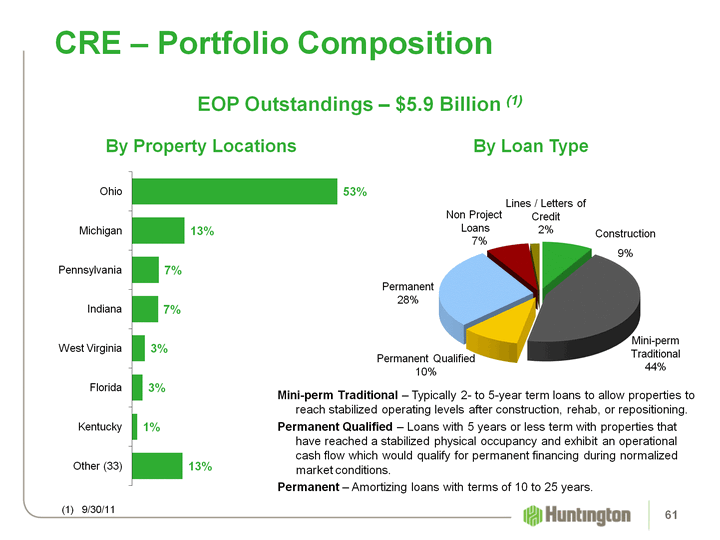
| (CHART) CRE - Portfolio Composition Permanent 28% Mini-perm Traditional 44% Construction 9% Non Project Loans 7% (CHART) Lines / Letters of Credit 2% (1) 9/30/11 Permanent Qualified 10% Mini-perm Traditional - Typically 2- to 5-year term loans to allow properties to reach stabilized operating levels after construction, rehab, or repositioning. Permanent Qualified - Loans with 5 years or less term with properties that have reached a stabilized physical occupancy and exhibit an operational cash flow which would qualify for permanent financing during normalized market conditions. Permanent - Amortizing loans with terms of 10 to 25 years. EOP Outstandings - $5.9 Billion (1) By Loan Type By Property Locations 61 |
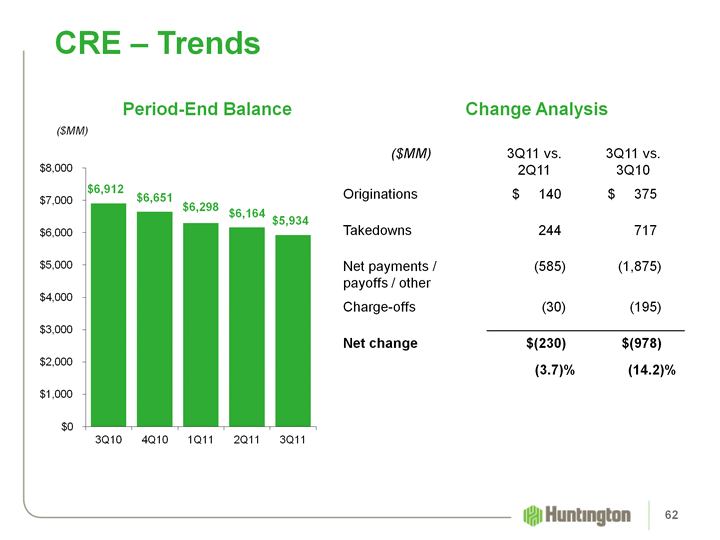
| (CHART) CRE - Trends ($MM) Change Analysis Period-End Balance ($MM) 3Q11 vs. 2Q11 3Q11 vs. 3Q10 Originations $ 140 $ 375 Takedowns 244 717 Net payments / payoffs / other (585) (1,875) Charge-offs (30) (195) Net change $(230) $(978) (3.7)% (14.2)% 62 |
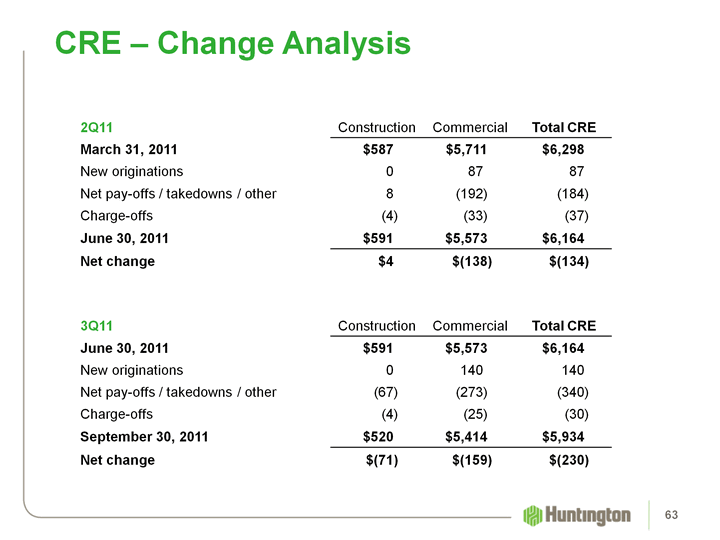
| CRE - Change Analysis 2Q11 Construction Commercial Total CRE March 31, 2011 $587 $5,711 $6,298 New originations 0 87 87 Net pay-offs / takedowns / other 8 (192) (184) Charge-offs (4) (33) (37) June 30, 2011 $591 $5,573 $6,164 Net change $4 $(138) $(134) 3Q11 Construction Commercial Total CRE June 30, 2011 $591 $5,573 $6,164 New originations 0 140 140 Net pay-offs / takedowns / other (67) (273) (340) Charge-offs (4) (25) (30) September 30, 2011 $520 $5,414 $5,934 Net change $(71) $(159) $(230) 63 |
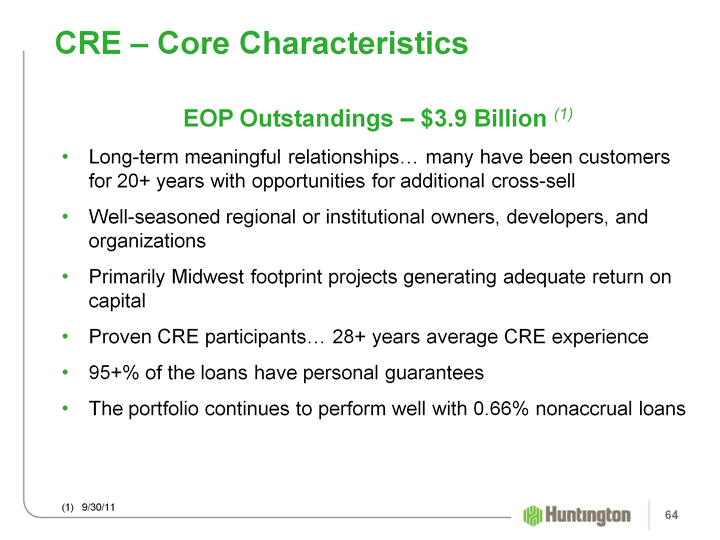
| CRE - Core Characteristics EOP Outstandings - $3.9 Billion (1) Long-term meaningful relationships... many have been customers for 20+ years with opportunities for additional cross-sell Well-seasoned regional or institutional owners, developers, and organizations Primarily Midwest footprint projects generating adequate return on capital Proven CRE participants... 28+ years average CRE experience 95+% of the loans have personal guarantees The portfolio continues to perform well with 0.66% nonaccrual loans (1) 9/30/11 64 |
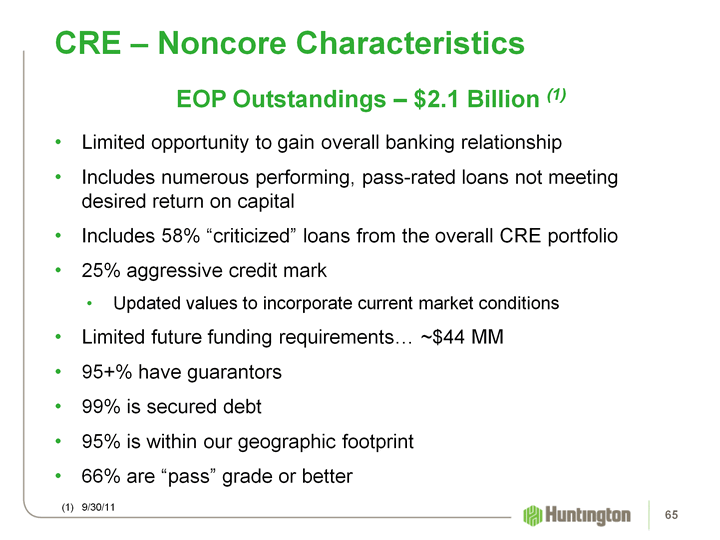
| CRE - Noncore Characteristics EOP Outstandings - $2.1 Billion (1) Limited opportunity to gain overall banking relationship Includes numerous performing, pass-rated loans not meeting desired return on capital Includes 58% "criticized" loans from the overall CRE portfolio 25% aggressive credit mark Updated values to incorporate current market conditions Limited future funding requirements... ~$44 MM 95+% have guarantors 99% is secured debt 95% is within our geographic footprint 66% are "pass" grade or better (1) 9/30/11 65 |

| Special Assets Department (SAD) ($0.9 Billion) 42% aggressive credit mark Actively working to exit... more aggressive terms - e.g., higher pricing, shorter amortization, sale, etc. 72% of "criticized" loans are managed within SAD Other ($1.2 Billion) 9% credit mark represents... 3.4x coverage of NALs 30+ days past due of only $22 MM (1.94%) Includes $458 MM of small dollar Investment Real Estate loans Not a strategic focus going forward Very granular risk assessment Actively managing within the context of an exit orientation... though may have opportunities to develop some into fuller, more profitable relationships CRE - Noncore Characteristics 66 |

| CRE - Core vs. Noncore ($MM) O/S ACL Criticized NALs Prior Charge-offs(1) ACL Credit Mark (2) 6/30/11 Core Total $3,985 $140 $424 $26 $ 11 3.51% 3.78% Noncore SAD 988 236 616 239 322 23.89 42.60 Noncore Other 1,191 95 224 26 13 7.98 8.97 Noncore Total 2,179 331 840 266 335 15.19 26.49 CRE Total $6,164 $471 $1,263 $292 $346 7.64% 12.55% 9/30/11 Core Total $3,871 $122 $504 $25 $ 16 3.15% 3.55% Noncore SAD 910 213 502 202 286 23.41 41.72 Noncore Other 1,153 89 196 30 14 7.72 8.83 Noncore Total 2,063 302 698 232 300 14.64 25.48 CRE Total $5,934 $424 $1,202 $257 $316 7.15% 11.84% (1) Prior charge-offs represent activity on existing accounts as of date shown, not cumulative for the portfolio (2) Credit mark = (ACL + prior charge-offs) / (outstandings + prior charge-offs) 67 |

| CRE - Core vs. Noncore Change Analysis 2Q11 Core Noncore Total CRE March 31, 2011 $3,912 $2,387 $6,298 Originations 87 0 87 Net payments / takedowns / other (45) (140) (185) Charge-offs (3) (34) (37) Classification changes 35 (34) 1 June 30, 2011 $3,985 $2,179 $6,164 3Q11 Core Noncore Total CRE June 30, 2011 $3,985 $2,179 $6,164 Originations 140 0 140 Net payments / takedowns / other (211) (112) (322) Charge-offs (5) (24) (30) Classification changes (37) 20 (18) September 30, 2011 $3,872 $2,063 $5,934 Net change $ (113) $ (116) $ (230) 68 |
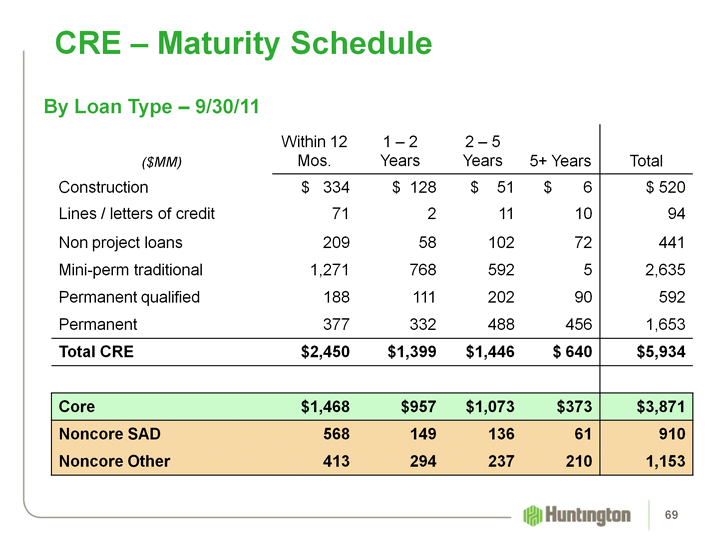
| CRE - Maturity Schedule By Loan Type - 9/30/11 ($MM) Within 12 Mos. 1 - 2 Years 2 - 5 Years 5+ Years Total Construction $ 334 $ 128 $ 51 $ 6 $ 520 Lines / letters of credit 71 2 11 10 94 Non project loans 209 58 102 72 441 Mini-perm traditional 1,271 768 592 5 2,635 Permanent qualified 188 111 202 90 592 Permanent 377 332 488 456 1,653 Total CRE $2,450 $1,399 $1,446 $ 640 $5,934 Core $1,468 $957 $1,073 $373 $3,871 Noncore SAD 568 149 136 61 910 Noncore Other 413 294 237 210 1,153 69 |
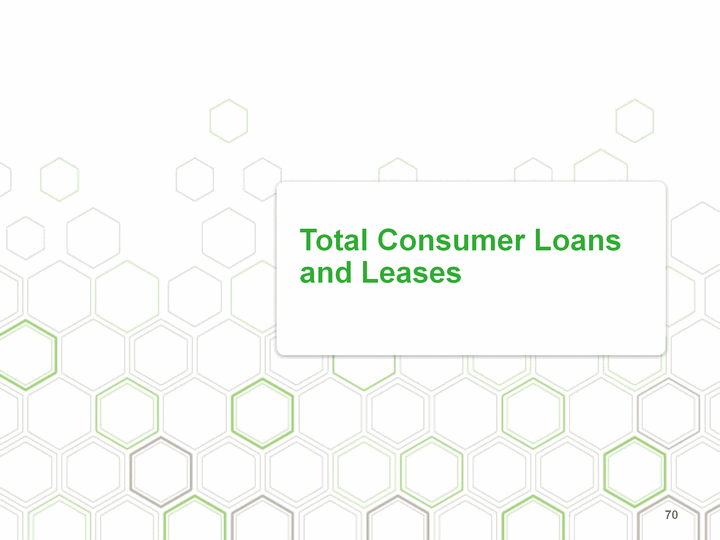
| Total Consumer Loans and Leases 70 |
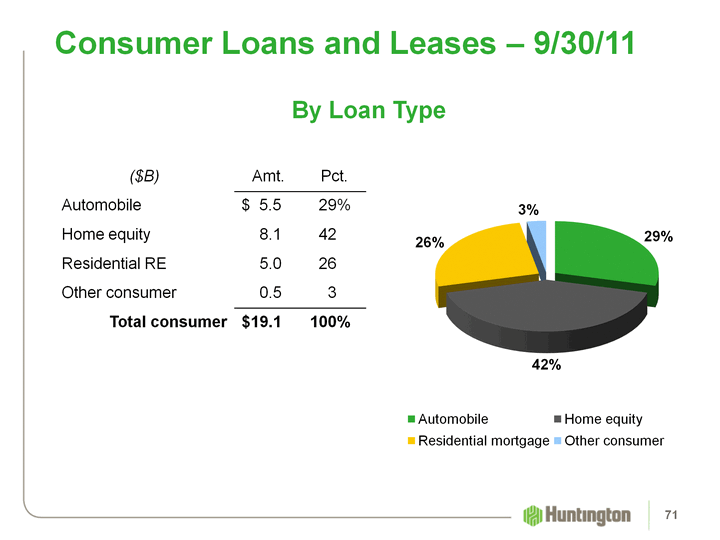
| Consumer Loans and Leases - 9/30/11 ($B) Amt. Pct. Automobile $ 5.5 29% Home equity 8.1 42 Residential RE 5.0 26 Other consumer 0.5 3 Total consumer $19.1 100% (CHART) By Loan Type 71 |
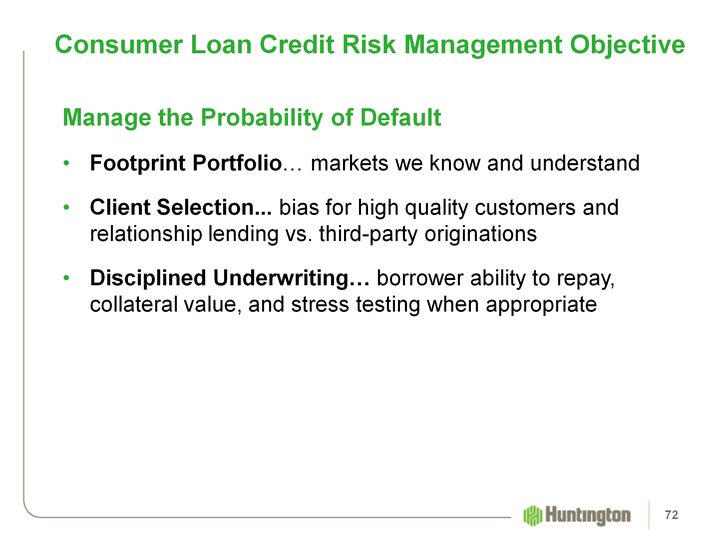
| Consumer Loan Credit Risk Management Objective Manage the Probability of Default Footprint Portfolio... markets we know and understand Client Selection... bias for high quality customers and relationship lending vs. third-party originations Disciplined Underwriting... borrower ability to repay, collateral value, and stress testing when appropriate 72 |
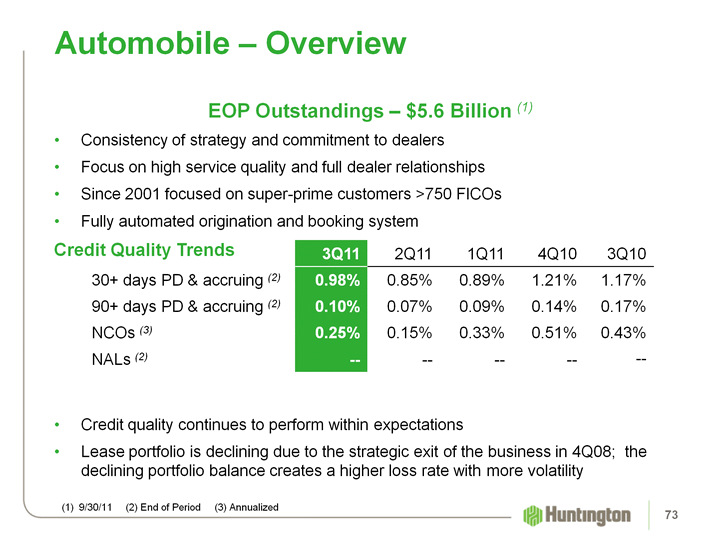
| Automobile - Overview EOP Outstandings - $5.6 Billion (1) Consistency of strategy and commitment to dealers Focus on high service quality and full dealer relationships Since 2001 focused on super-prime customers >750 FICOs Fully automated origination and booking system Credit Quality Trends Credit quality continues to perform within expectations Lease portfolio is declining due to the strategic exit of the business in 4Q08; the declining portfolio balance creates a higher loss rate with more volatility 3Q11 2Q11 1Q11 4Q10 3Q10 30+ days PD & accruing (2) 0.98% 0.85% 0.89% 1.21% 1.17% 90+ days PD & accruing (2) 0.10% 0.07% 0.09% 0.14% 0.17% NCOs (3) 0.25% 0.15% 0.33% 0.51% 0.43% NALs (2) -- -- -- -- -- 73 (1) 9/30/11 (2) End of Period (3) Annualized |
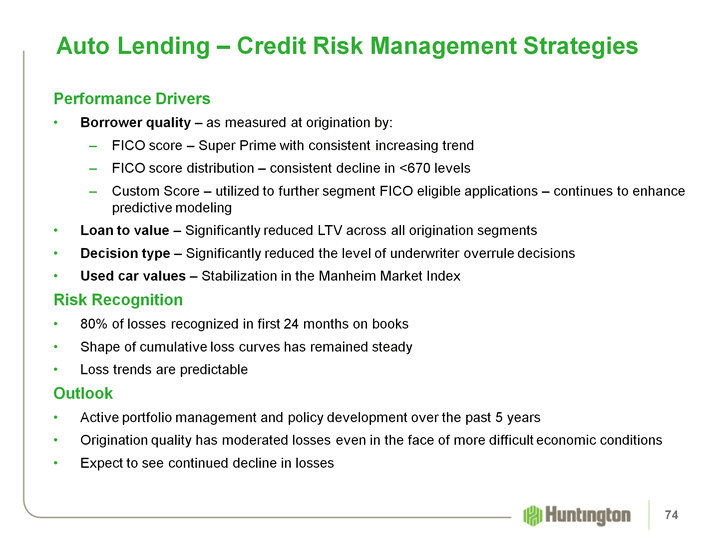
| Auto Lending - Credit Risk Management Strategies Performance Drivers Borrower quality - as measured at origination by: FICO score - Super Prime with consistent increasing trend FICO score distribution - consistent decline in <670 levels Custom Score - utilized to further segment FICO eligible applications - continues to enhance predictive modeling Loan to value - Significantly reduced LTV across all origination segments Decision type - Significantly reduced the level of underwriter overrule decisions Used car values - Stabilization in the Manheim Market Index Risk Recognition 80% of losses recognized in first 24 months on books Shape of cumulative loss curves has remained steady Loss trends are predictable Outlook Active portfolio management and policy development over the past 5 years Origination quality has moderated losses even in the face of more difficult economic conditions Expect to see continued decline in losses 74 |
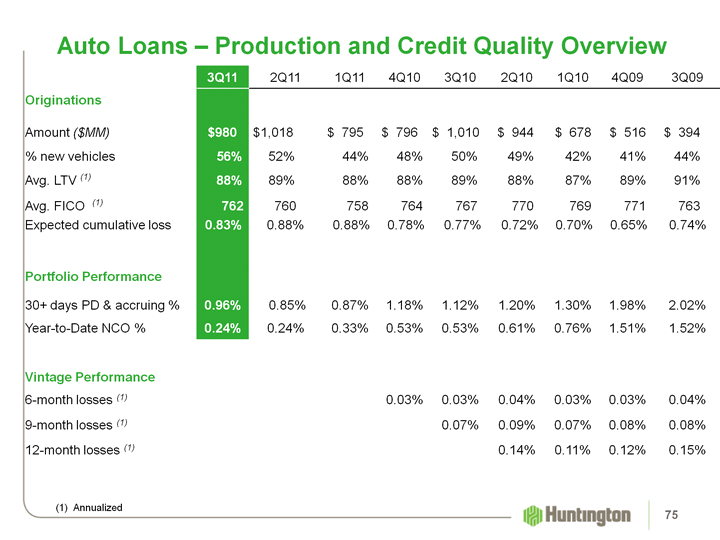
| Auto Loans - Production and Credit Quality Overview Auto Loans - Production and Credit Quality Overview (1) Annualized 75 |
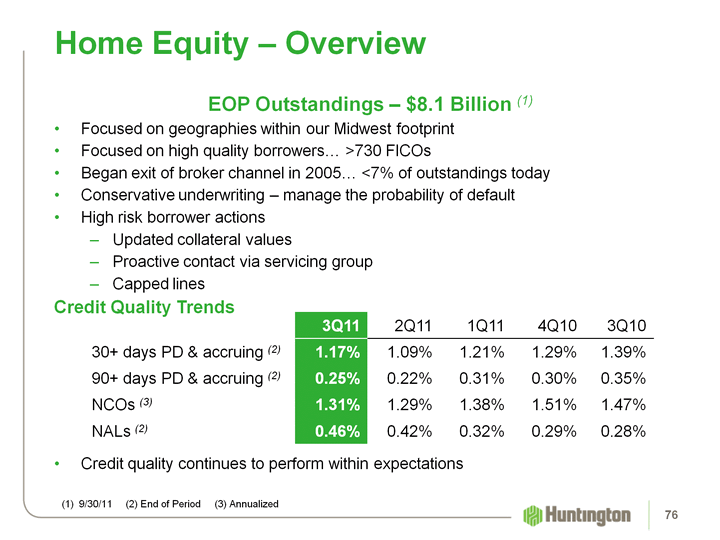
| Home Equity - Overview EOP Outstandings - $8.1 Billion (1) Focused on geographies within our Midwest footprint Focused on high quality borrowers... >730 FICOs Began exit of broker channel in 2005... <7% of outstandings today Conservative underwriting - manage the probability of default High risk borrower actions Updated collateral values Proactive contact via servicing group Capped lines Credit Quality Trends Credit quality continues to perform within expectations 3Q11 2Q11 1Q11 4Q10 3Q10 30+ days PD & accruing (2) 1.17% 1.09% 1.21% 1.29% 1.39% 90+ days PD & accruing (2) 0.25% 0.22% 0.31% 0.30% 0.35% NCOs (3) 1.31% 1.29% 1.38% 1.51% 1.47% NALs (2) 0.46% 0.42% 0.32% 0.29% 0.28% 76 (1) 9/30/11 (2) End of Period (3) Annualized |
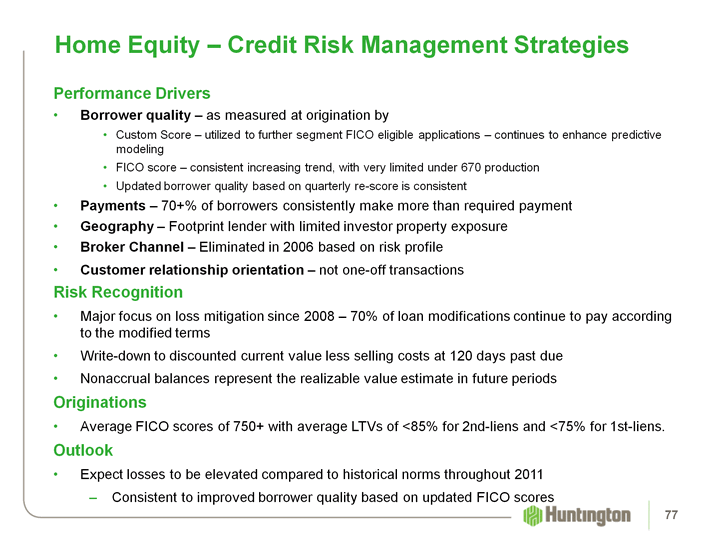
| Home Equity - Credit Risk Management Strategies Performance Drivers Borrower quality - as measured at origination by Custom Score - utilized to further segment FICO eligible applications - continues to enhance predictive modeling FICO score - consistent increasing trend, with very limited under 670 production Updated borrower quality based on quarterly re-score is consistent Payments - 70+% of borrowers consistently make more than required payment Geography - Footprint lender with limited investor property exposure Broker Channel - Eliminated in 2006 based on risk profile Customer relationship orientation - not one-off transactions Risk Recognition Major focus on loss mitigation since 2008 - 70% of loan modifications continue to pay according to the modified terms Write-down to discounted current value less selling costs at 120 days past due Nonaccrual balances represent the realizable value estimate in future periods Originations Average FICO scores of 750+ with average LTVs of <85% for 2nd-liens and <75% for 1st-liens. Outlook Expect losses to be elevated compared to historical norms throughout 2011 Consistent to improved borrower quality based on updated FICO scores 77 |
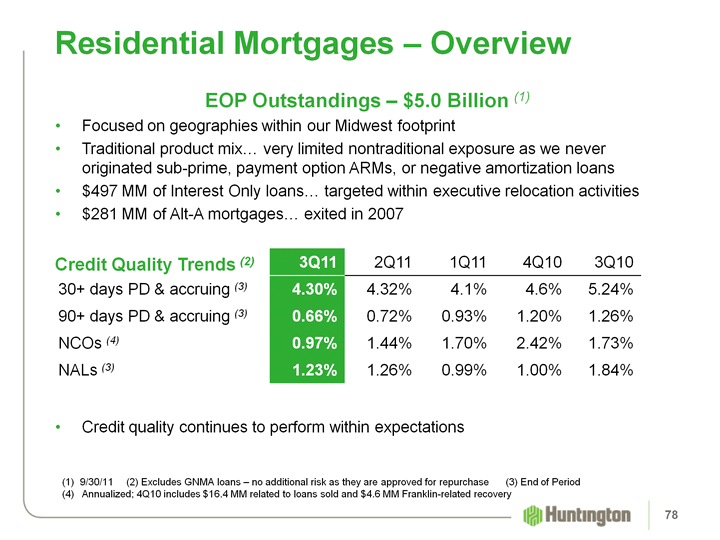
| EOP Outstandings - $5.0 Billion (1) Focused on geographies within our Midwest footprint Traditional product mix... very limited nontraditional exposure as we never originated sub-prime, payment option ARMs, or negative amortization loans $497 MM of Interest Only loans... targeted within executive relocation activities $281 MM of Alt-A mortgages... exited in 2007 Credit Quality Trends (2) Credit quality continues to perform within expectations 3Q11 2Q11 1Q11 4Q10 3Q10 30+ days PD & accruing (3) 4.30% 4.32% 4.1% 4.6% 5.24% 90+ days PD & accruing (3) 0.66% 0.72% 0.93% 1.20% 1.26% NCOs (4) 0.97% 1.44% 1.70% 2.42% 1.73% NALs (3) 1.23% 1.26% 0.99% 1.00% 1.84% Residential Mortgages - Overview 78 9/30/11 (2) Excludes GNMA loans - no additional risk as they are approved for repurchase (3) End of Period (4) Annualized; 4Q10 includes $16.4 MM related to loans sold and $4.6 MM Franklin-related recovery |

| Residential Mortgages - Credit Risk Management Strategies Performance Drivers Standard products and borrower quality - as measured at origination by: Secondary market underwriting FICO score - consistent increasing trend FICO score distribution - consistent decline in low score levels Non-standard product structures $497 MM of Interest Only loans... targeted within executive relocation activities... continues to perform well $281 MM of Alt-A mortgages... exited in 2007... represents 6% of total residential portfolio with majority of cumulative losses likely recognized within 24 months Decision type - Significantly reduced the level of underwriter overrule decisions Geography - Primarily a footprint lender 79 |
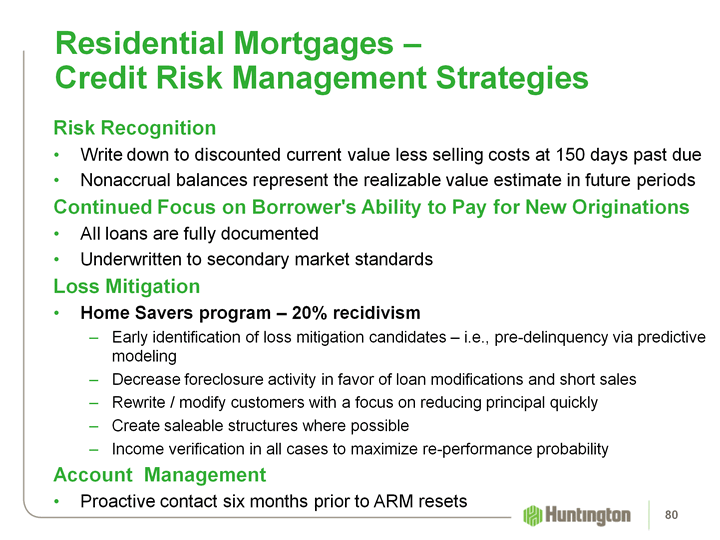
| Residential Mortgages - Credit Risk Management Strategies Risk Recognition Write down to discounted current value less selling costs at 150 days past due Nonaccrual balances represent the realizable value estimate in future periods Continued Focus on Borrower's Ability to Pay for New Originations All loans are fully documented Underwritten to secondary market standards Loss Mitigation Home Savers program - 20% recidivism Early identification of loss mitigation candidates - i.e., pre-delinquency via predictive modeling Decrease foreclosure activity in favor of loan modifications and short sales Rewrite / modify customers with a focus on reducing principal quickly Create saleable structures where possible Income verification in all cases to maximize re-performance probability Account Management Proactive contact six months prior to ARM resets 80 |
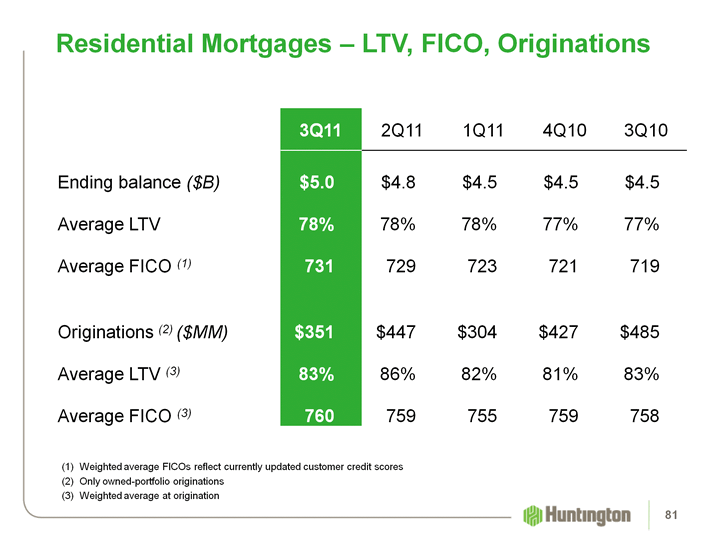
| Residential Mortgages - LTV, FICO, Originations (1) Weighted average FICOs reflect currently updated customer credit scores (2) Only owned-portfolio originations Weighted average at origination 3Q11 2Q11 1Q11 4Q10 3Q10 Ending balance ($B) $5.0 $4.8 $4.5 $4.5 $4.5 Average LTV 78% 78% 78% 77% 77% Average FICO (1) 731 729 723 721 719 Originations (2) ($MM) $351 $447 $304 $427 $485 Average LTV (3) 83% 86% 82% 81% 83% Average FICO (3) 760 759 755 759 758 81 |
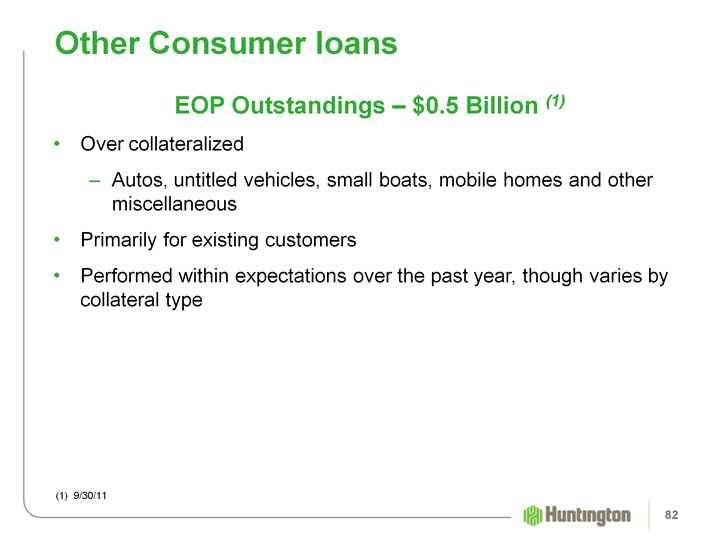
| Other Consumer loans EOP Outstandings - $0.5 Billion (1) Over collateralized Autos, untitled vehicles, small boats, mobile homes and other miscellaneous Primarily for existing customers Performed within expectations over the past year, though varies by collateral type (1) 9/30/11 82 |
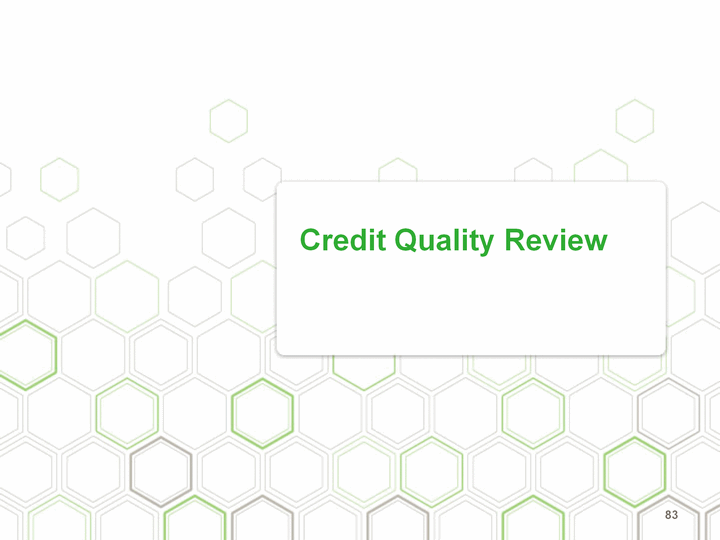
| Credit Quality Review 83 |
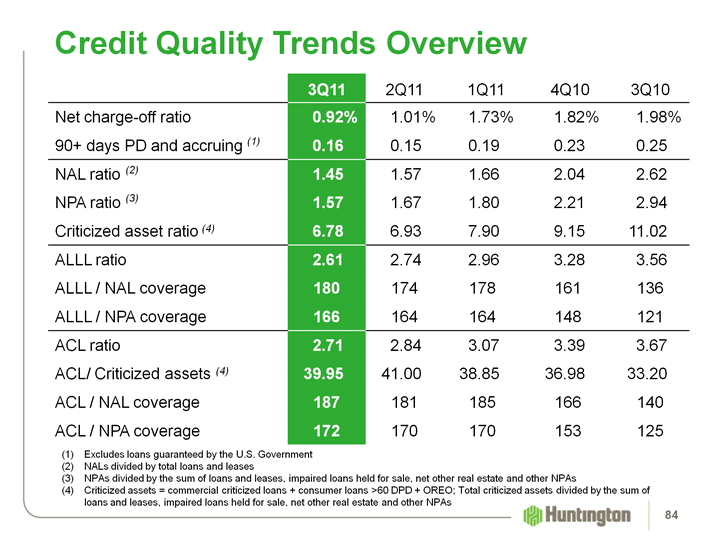
| Credit Quality Trends Overview Credit Quality Trends Overview Excludes loans guaranteed by the U.S. Government NALs divided by total loans and leases (3) NPAs divided by the sum of loans and leases, impaired loans held for sale, net other real estate and other NPAs (4) Criticized assets = commercial criticized loans + consumer loans >60 DPD + OREO; Total criticized assets divided by the sum of loans and leases, impaired loans held for sale, net other real estate and other NPAs 84 |
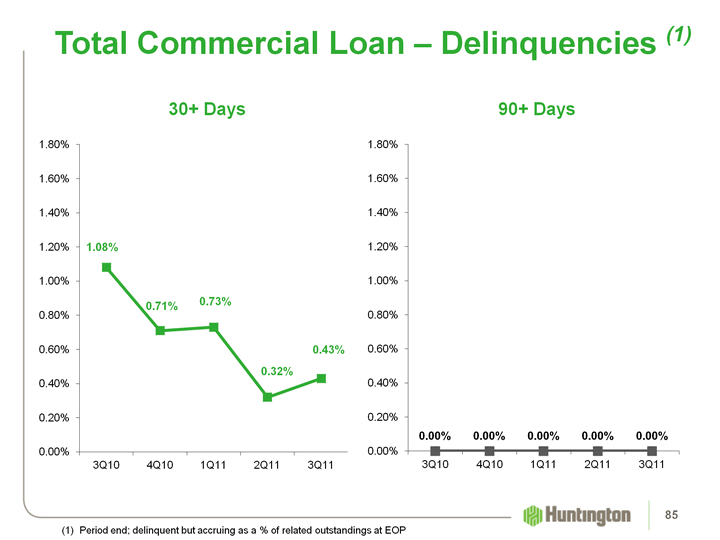
| Total Commercial Loan - Delinquencies (1) (CHART) (CHART) (1) Period end; delinquent but accruing as a % of related outstandings at EOP 90+ Days 30+ Days 85 |
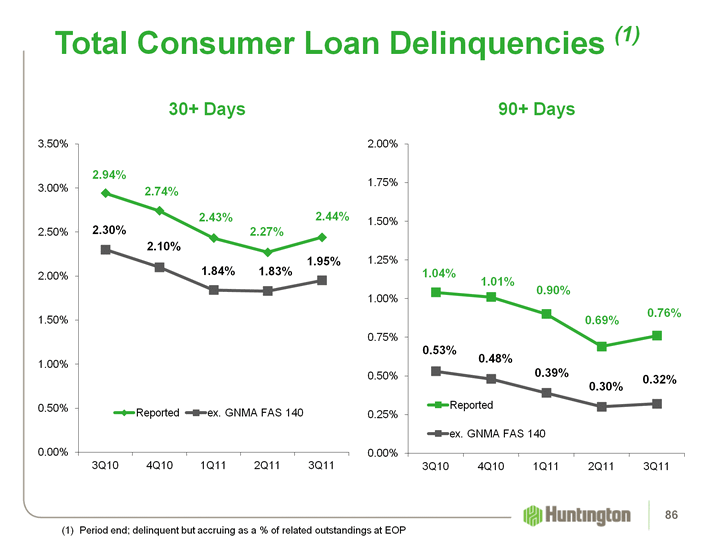
| (CHART) Total Consumer Loan Delinquencies (1) (CHART) 90+ Days 30+ Days (1) Period end; delinquent but accruing as a % of related outstandings at EOP 86 |
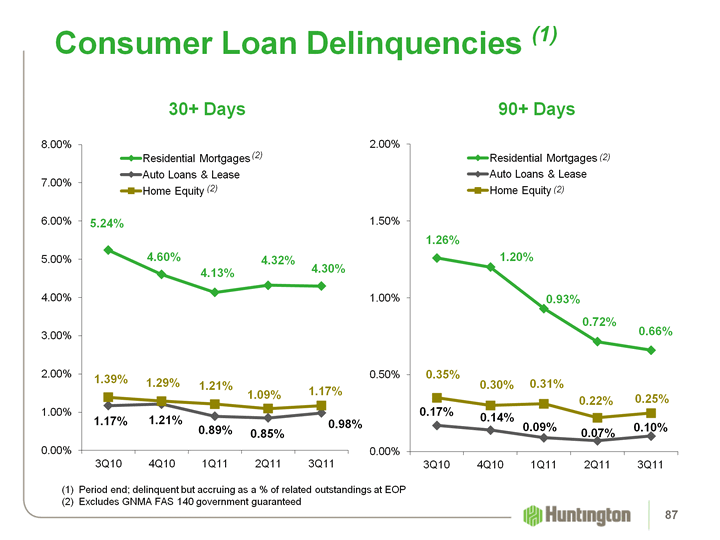
| Consumer Loan Delinquencies (1) (CHART) (1) Period end; delinquent but accruing as a % of related outstandings at EOP (2) Excludes GNMA FAS 140 government guaranteed (CHART) (2) (2) (2) (2) 90+ Days 30+ Days 87 |

| (CHART) Net Charge-Offs ($MM) ($MM) Consumer Loans Commercial Loans (2) (CHART) (1) Includes $16.4 MM related to $39.8 MM of residential mortgages sold and a $4.4 MM Franklin-related recovery (1) 88 |
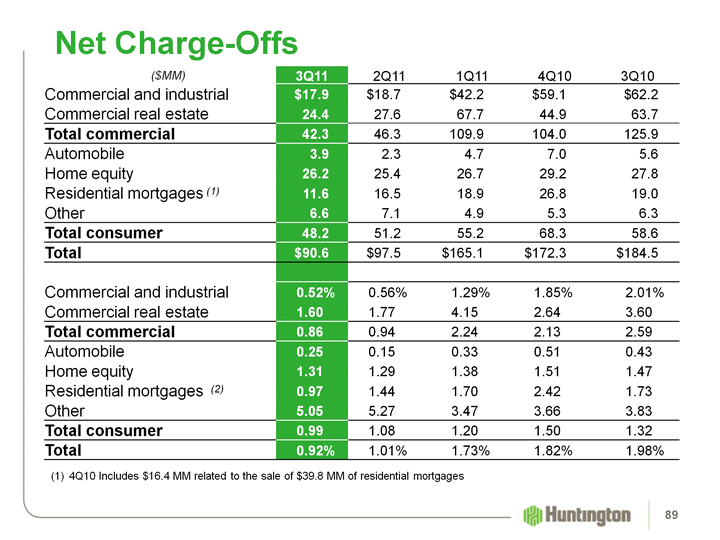
| Net Charge-Offs ($MM) 3Q11 2Q11 1Q11 4Q10 3Q10 Commercial and industrial $17.9 $18.7 $42.2 $59.1 $62.2 Commercial real estate 24.4 27.6 67.7 44.9 63.7 Total commercial 42.3 46.3 109.9 104.0 125.9 Automobile 3.9 2.3 4.7 7.0 5.6 Home equity 26.2 25.4 26.7 29.2 27.8 Residential mortgages (1) 11.6 16.5 18.9 26.8 19.0 Other 6.6 7.1 4.9 5.3 6.3 Total consumer 48.2 51.2 55.2 68.3 58.6 Total $90.6 $97.5 $165.1 $172.3 $184.5 Commercial and industrial 0.52% 0.56% 1.29% 1.85% 2.01% Commercial real estate 1.60 1.77 4.15 2.64 3.60 Total commercial 0.86 0.94 2.24 2.13 2.59 Automobile 0.25 0.15 0.33 0.51 0.43 Home equity 1.31 1.29 1.38 1.51 1.47 Residential mortgages (2) 0.97 1.44 1.70 2.42 1.73 Other 5.05 5.27 3.47 3.66 3.83 Total consumer 0.99 1.08 1.20 1.50 1.32 Total 0.92% 1.01% 1.73% 1.82% 1.98% 4Q10 Includes $16.4 MM related to the sale of $39.8 MM of residential mortgages 89 |

| (CHART) Nonaccrual Loans and Nonperforming Assets ($MM) (CHART) ($MM) (15)% (18)% (18)% (21)% (62)% NAL Inflows NALs & NPAs - EOP (3)% (19)% (8)% (27)% 10% 90 |
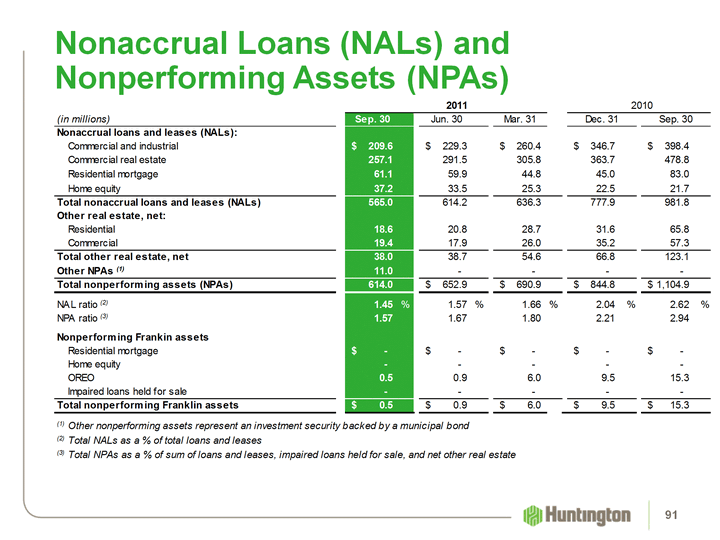
| Nonaccrual Loans (NALs) and Nonperforming Assets (NPAs) 91 |
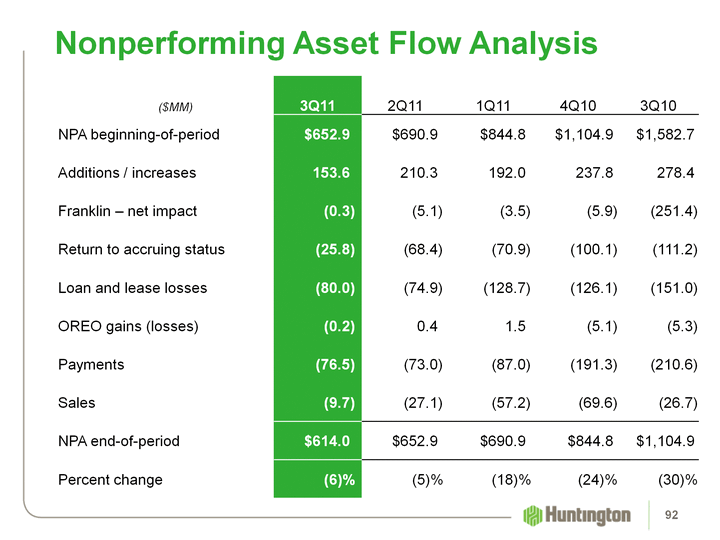
| ($MM) 3Q11 2Q11 1Q11 4Q10 3Q10 NPA beginning-of-period $652.9 $690.9 $844.8 $1,104.9 $1,582.7 Additions / increases 153.6 210.3 192.0 237.8 278.4 Franklin - net impact (0.3) (5.1) (3.5) (5.9) (251.4) Return to accruing status (25.8) (68.4) (70.9) (100.1) (111.2) Loan and lease losses (80.0) (74.9) (128.7) (126.1) (151.0) OREO gains (losses) (0.2) 0.4 1.5 (5.1) (5.3) Payments (76.5) (73.0) (87.0) (191.3) (210.6) Sales (9.7) (27.1) (57.2) (69.6) (26.7) NPA end-of-period $614.0 $652.9 $690.9 $844.8 $1,104.9 Percent change (6)% (5)% (18)% (24)% (30)% Nonperforming Asset Flow Analysis 92 |
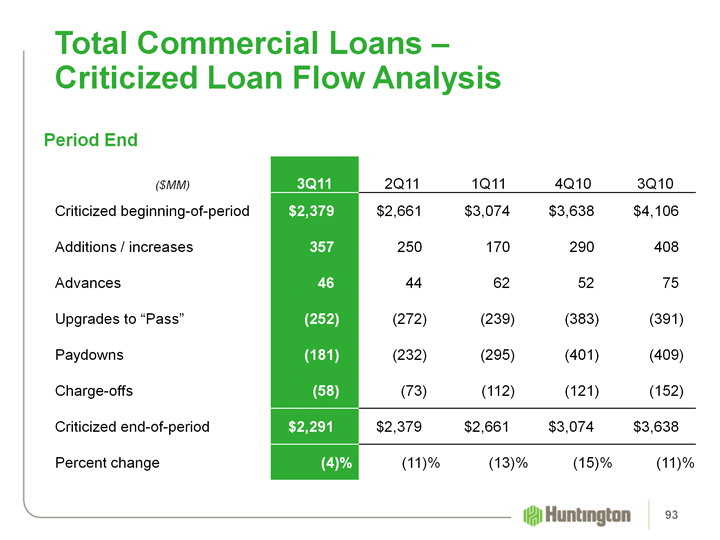
| ($MM) 3Q11 2Q11 1Q11 4Q10 3Q10 Criticized beginning-of-period $2,379 $2,661 $3,074 $3,638 $4,106 Additions / increases 357 250 170 290 408 Advances 46 44 62 52 75 Upgrades to "Pass" (252) (272) (239) (383) (391) Paydowns (181) (232) (295) (401) (409) Charge-offs (58) (73) (112) (121) (152) Criticized end-of-period $2,291 $2,379 $2,661 $3,074 $3,638 Percent change (4)% (11)% (13)% (15)% (11)% Total Commercial Loans - Criticized Loan Flow Analysis Period End 93 |

| Accruing Loans 90 Days Past Due and Troubled Debt Restructured Loans 94 |
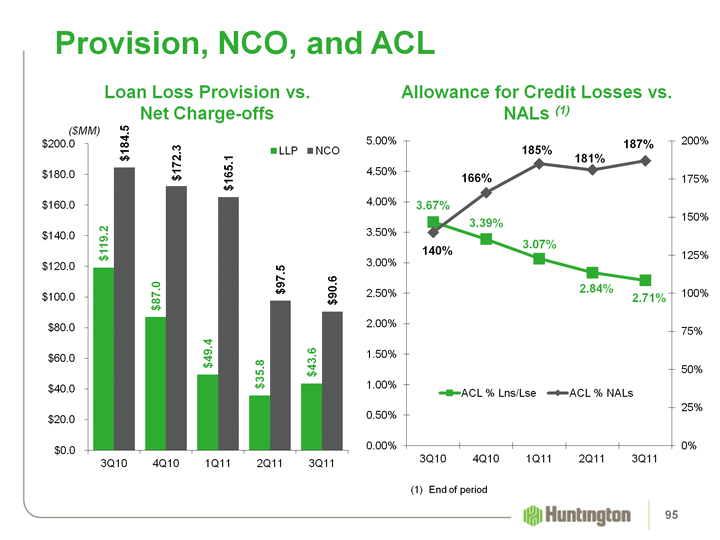
| (CHART) (CHART) Provision, NCO, and ACL ($MM) (1) End of period Allowance for Credit Losses vs. NALs (1) Loan Loss Provision vs. Net Charge-offs 95 |

| (CHART) Relative Performance - ALLL / NAL Coverage Source: SNL; company reports 96 |
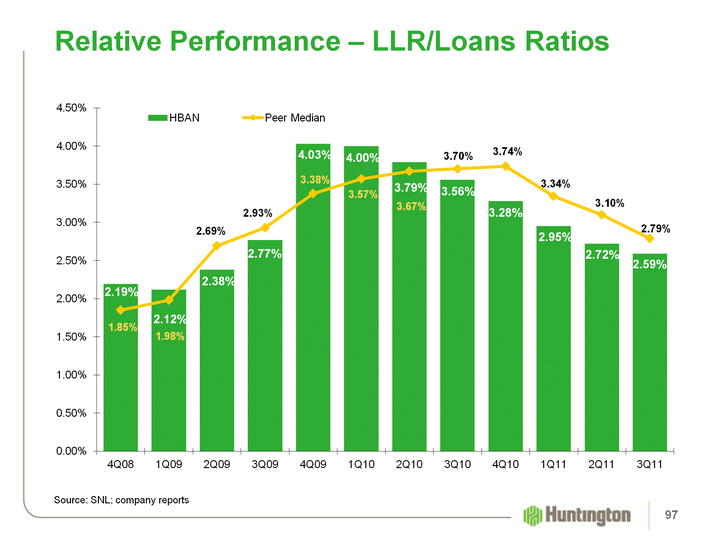
| (CHART) Relative Performance - LLR/Loans Ratios Source: SNL; company reports 97 |
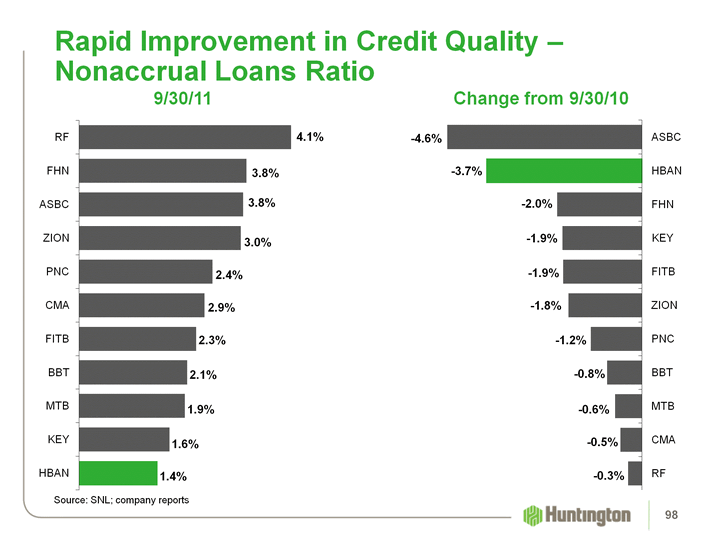
| Rapid Improvement in Credit Quality - Nonaccrual Loans Ratio 9/30/11 Change from 9/30/10 (CHART) Source: SNL; company reports (CHART) 98 |
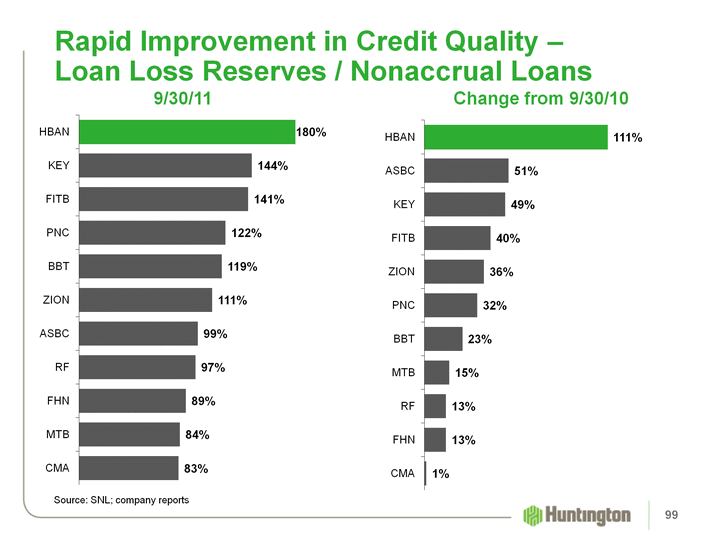
| Rapid Improvement in Credit Quality - Loan Loss Reserves / Nonaccrual Loans (CHART) (CHART) Source: SNL; company reports 9/30/11 Change from 9/30/10 99 |
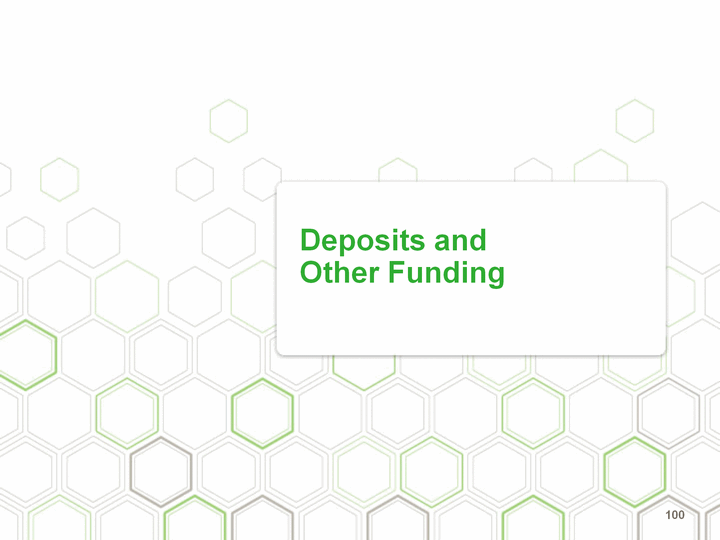
| Deposits and Other Funding 100 |
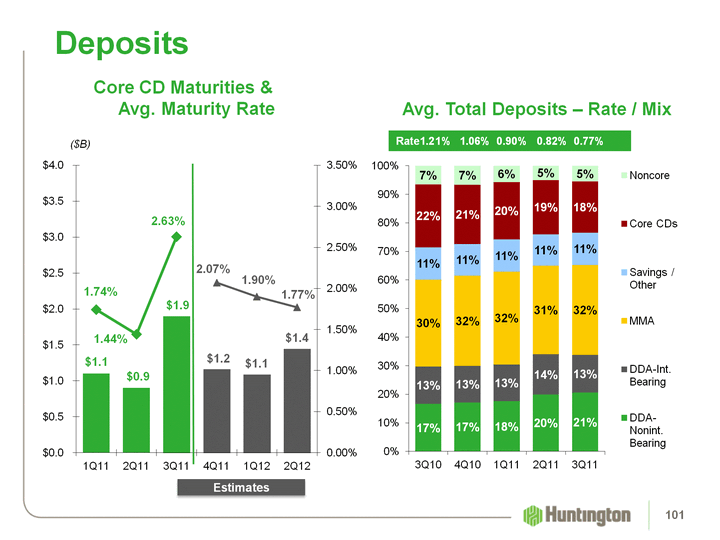
| (CHART) (CHART) Deposits ($B) Avg. Total Deposits - Rate / Mix Core CD Maturities & Avg. Maturity Rate Rate1.21% 1.06% 0.90% 0.82% 0.77% Estimates 101 |
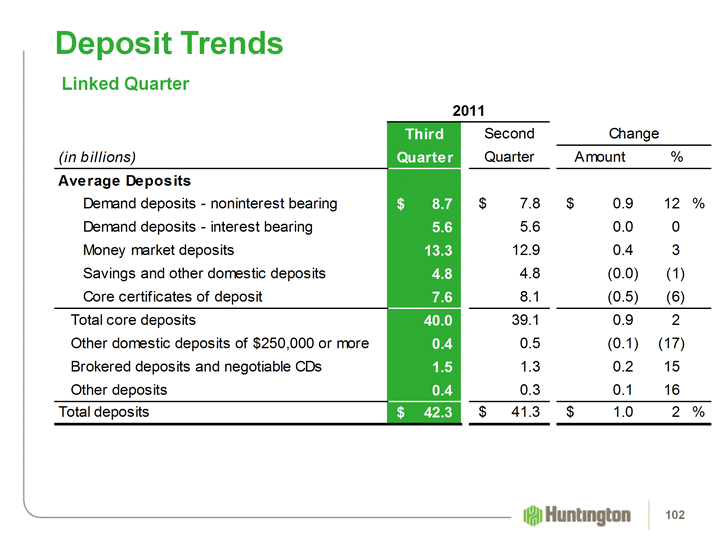
| Deposit Trends Linked Quarter 102 |
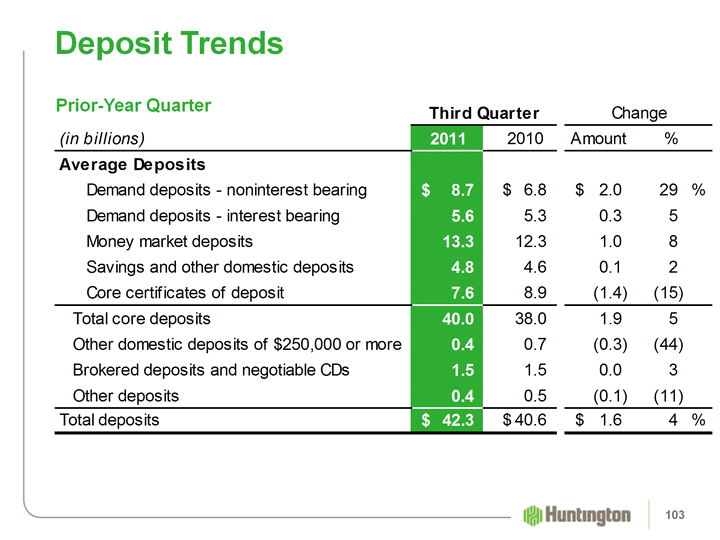
| Deposit Trends Prior-Year Quarter 103 |
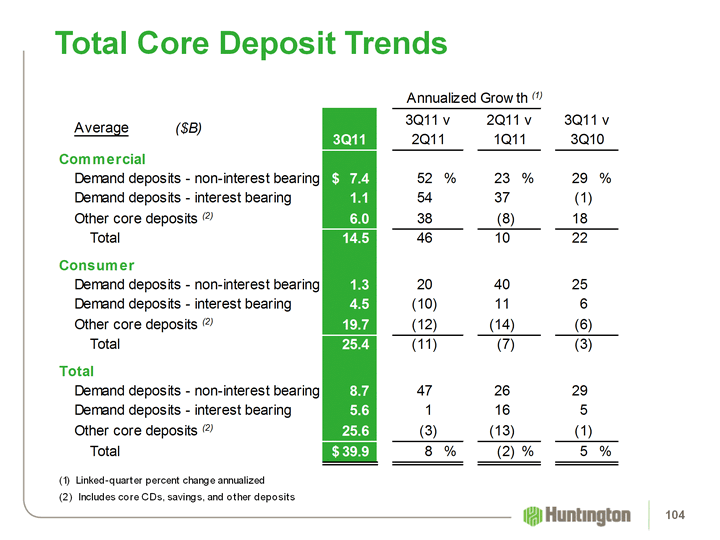
| Total Core Deposit Trends 104 |
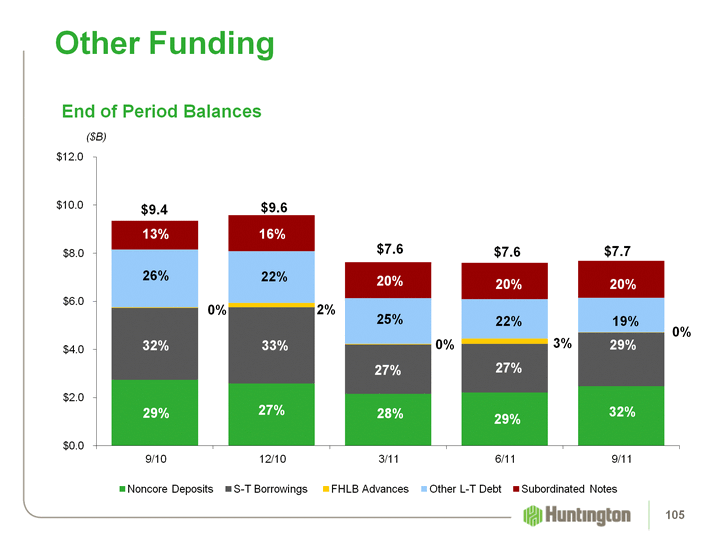
| (CHART) Other Funding End of Period Balances ($B) 26% 16% 0% 27% 13% $7.7 20% 3% 22% 32% 29% $9.4 20% 32% 2% 29% 28% 105 0% |
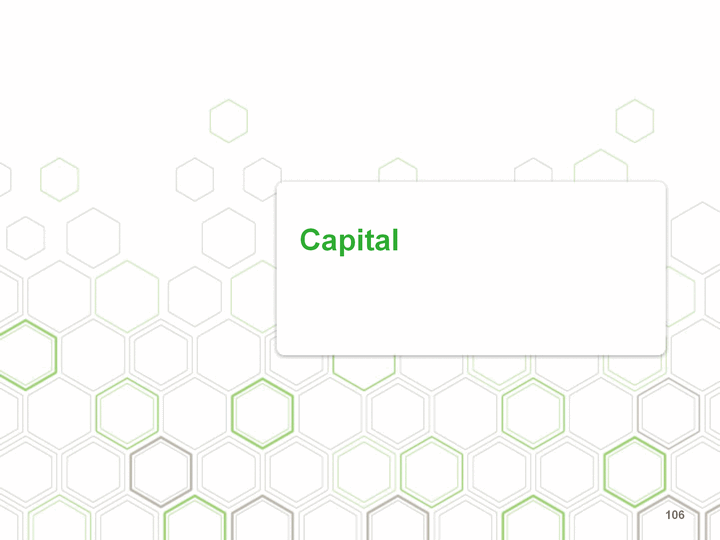
| Capital 106 |
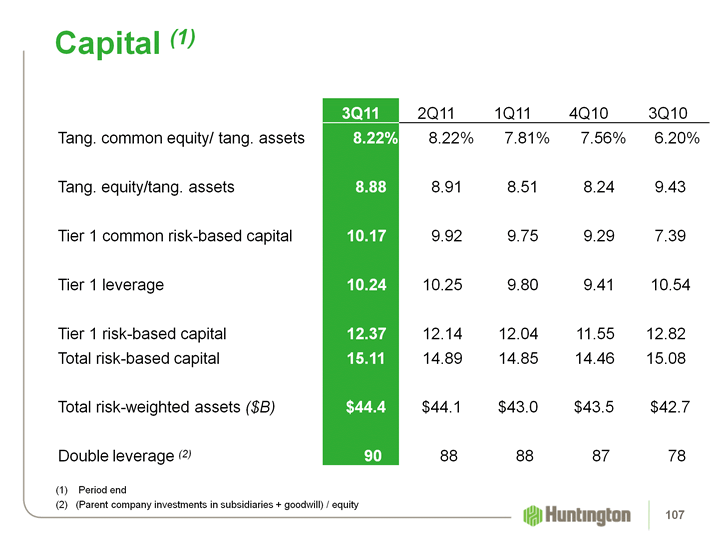
| Capital (1) 3Q11 2Q11 1Q11 4Q10 3Q10 Tang. common equity/ tang. assets 8.22% 8.22% 7.81% 7.56% 6.20% Tang. equity/tang. assets 8.88 8.91 8.51 8.24 9.43 Tier 1 common risk-based capital 10.17 9.92 9.75 9.29 7.39 Tier 1 leverage 10.24 10.25 9.80 9.41 10.54 Tier 1 risk-based capital 12.37 12.14 12.04 11.55 12.82 Total risk-based capital 15.11 14.89 14.85 14.46 15.08 Total risk-weighted assets ($B) $44.4 $44.1 $43.0 $43.5 $42.7 Double leverage (2) 90 88 88 87 78 (1) Period end (2) (Parent company investments in subsidiaries + goodwill) / equity 107 |
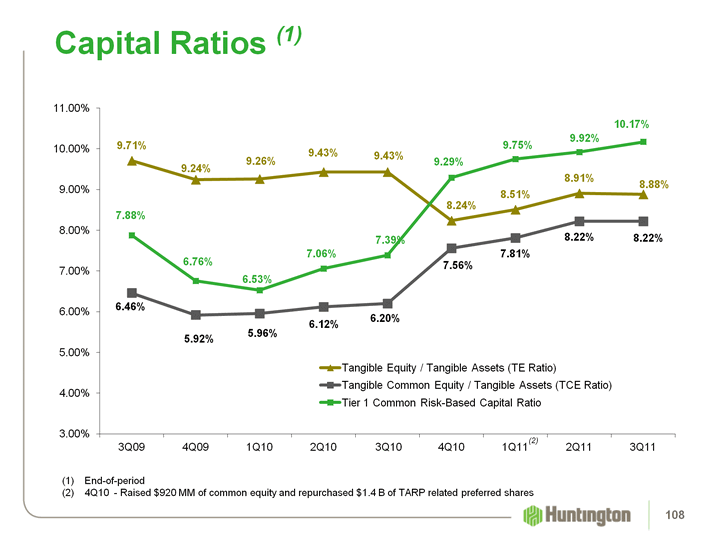
| (CHART) Capital Ratios (1) End-of-period 4Q10 - Raised $920 MM of common equity and repurchased $1.4 B of TARP related preferred shares (2) 108 |
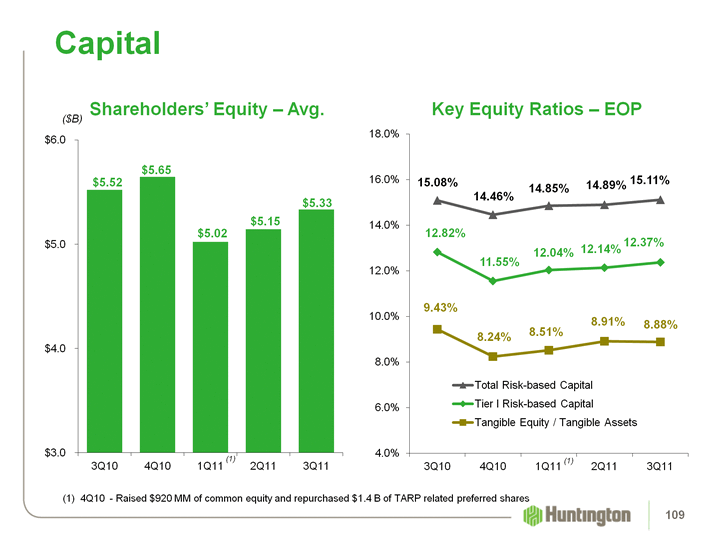
| (CHART) Shareholders' Equity - Avg. (CHART) Capital Key Equity Ratios - EOP ($B) 109 4Q10 - Raised $920 MM of common equity and repurchased $1.4 B of TARP related preferred shares |
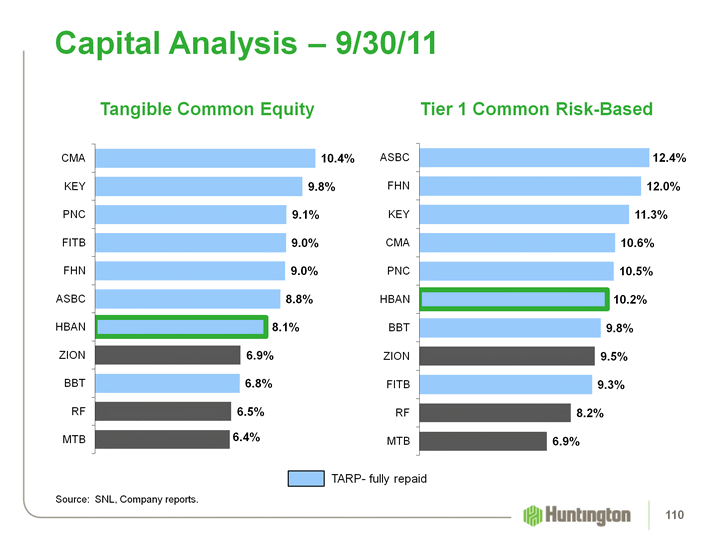
| (CHART) Capital Analysis - 9/30/11 (CHART) Source: SNL, Company reports. Tier 1 Common Risk-Based Tangible Common Equity TARP- fully repaid 110 |
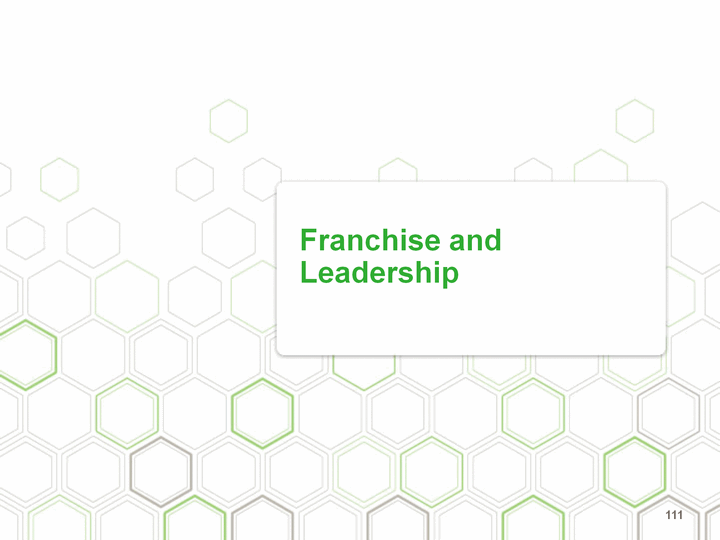
| Franchise and Leadership 111 |
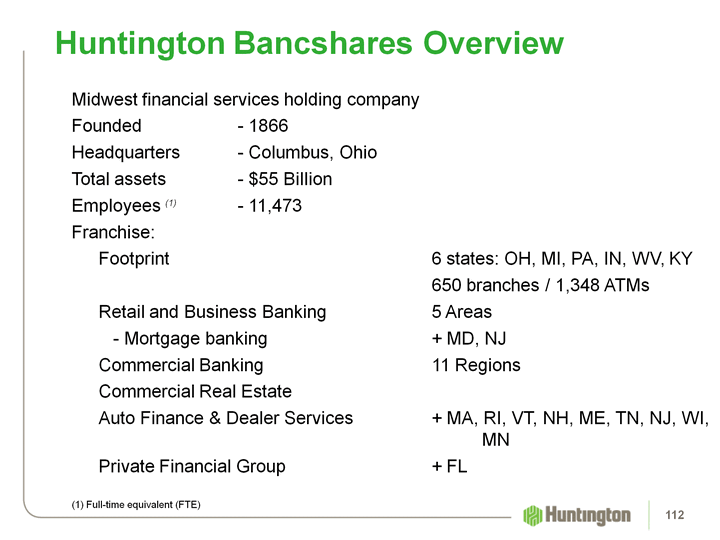
| Huntington Bancshares Overview Midwest financial services holding company Founded - 1866 Headquarters - Columbus, Ohio Total assets - $55 Billion Employees (1) - 11,473 Franchise: Footprint 6 states: OH, MI, PA, IN, WV, KY 650 branches / 1,348 ATMs Retail and Business Banking 5 Areas - Mortgage banking + MD, NJ Commercial Banking 11 Regions Commercial Real Estate Auto Finance & Dealer Services + MA, RI, VT, NH, ME, TN, NJ, WI, MN Private Financial Group + FL (1) Full-time equivalent (FTE) 112 |

| The Huntington Franchise Branches 119 ATMs 240 Detroit 4% Grand Rapids 10% Branches 365 ATMs 834 Akron 8% Canton 28% Cincinnati 3% Cleveland 8% Columbus 24% Dayton 6% Toledo 24% Youngstown 21% Branches 50 ATMs 70 Indianapolis 7% Branches 13 ATMs 26 Branches 30 ATMs 131 Charleston 10% Includes 14 PFG offices (2 in FL) and 2 ATMs in MD. Market share at 6/30/11 Branches 650(1) ATMs 1,348(1) Branches 58 ATMs 110 Pittsburgh 3% Branches 120 ATMs 175 Detroit 4% Grand Rapids 11% 113 |
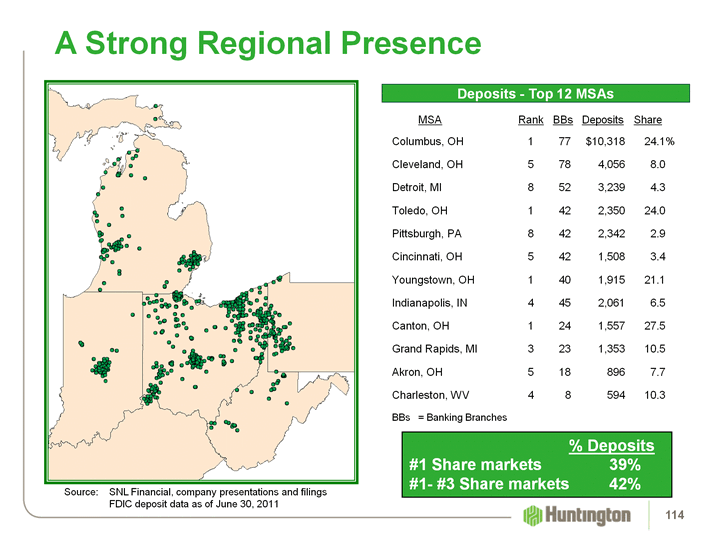
| A Strong Regional Presence Source: SNL Financial, company presentations and filings FDIC deposit data as of June 30, 2011 Deposits - Top 12 MSAs MSA Rank BBs Deposits Share Columbus, OH 1 77 $10,318 24.1% Cleveland, OH 5 78 4,056 8.0 Detroit, MI 8 52 3,239 4.3 Toledo, OH 1 42 2,350 24.0 Pittsburgh, PA 8 42 2,342 2.9 Cincinnati, OH 5 42 1,508 3.4 Youngstown, OH 1 40 1,915 21.1 Indianapolis, IN 4 45 2,061 6.5 Canton, OH 1 24 1,557 27.5 Grand Rapids, MI 3 23 1,353 10.5 Akron, OH 5 18 896 7.7 Charleston, WV 4 8 594 10.3 BBs = Banking Branches % Deposits #1 Share markets 39% #1- #3 Share markets 42% 114 |
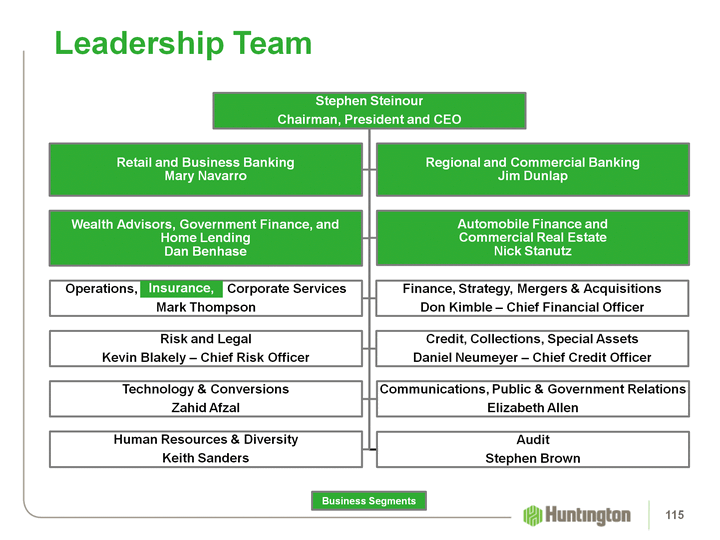
| Leadership Team Leadership Team Business Segments Insurance, 115 |
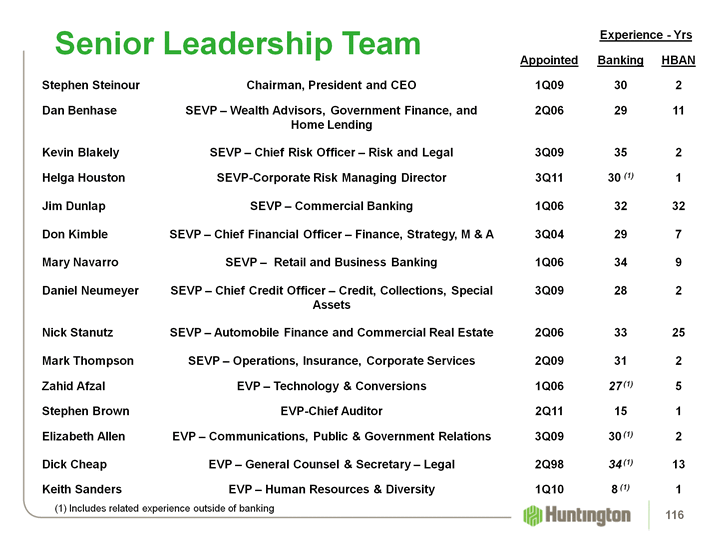
| Senior Leadership Team (1) Includes related experience outside of banking 116 |
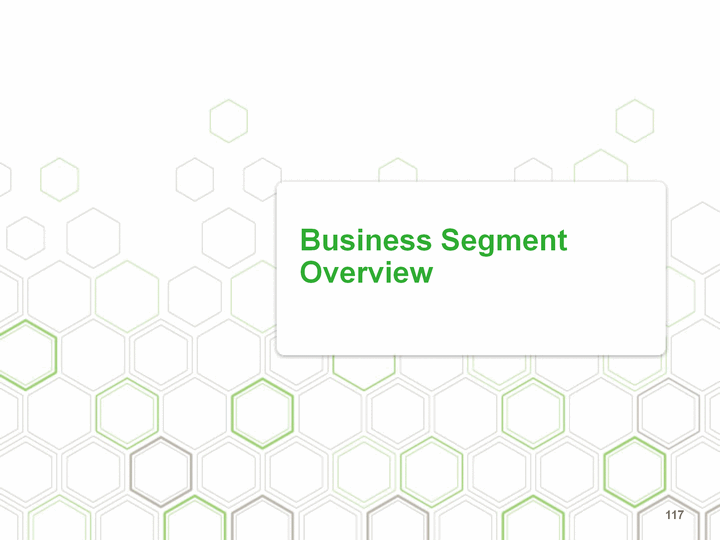
| Business Segment Overview 117 |
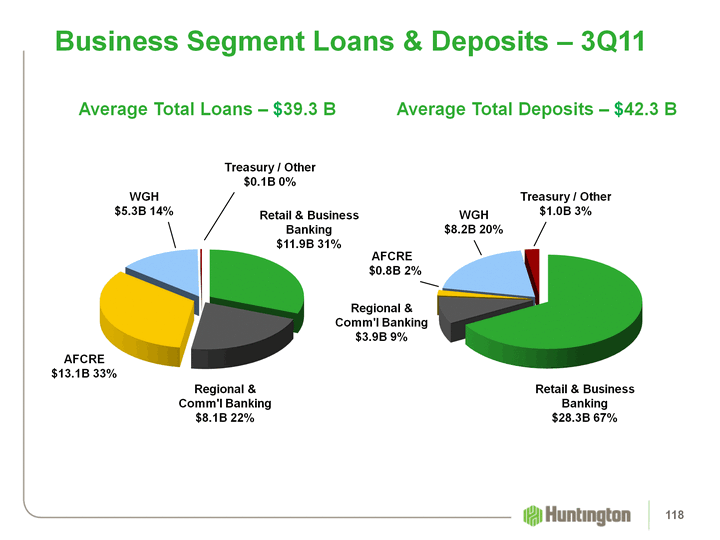
| Business Segment Loans & Deposits - 3Q11 Average Total Deposits - $42.3 B Average Total Loans - $39.3 B (CHART) (CHART) AFCRE $13.1B 33% Retail & Business Banking $11.9B 31% Treasury / Other $0.1B 0% Regional & Comm'l Banking $8.1B 22% WGH $5.3B 14% AFCRE $0.8B 2% Treasury / Other $1.0B 3% Retail & Business Banking $28.3B 67% Regional & Comm'l Banking $3.9B 9% WGH $8.2B 20% 118 |
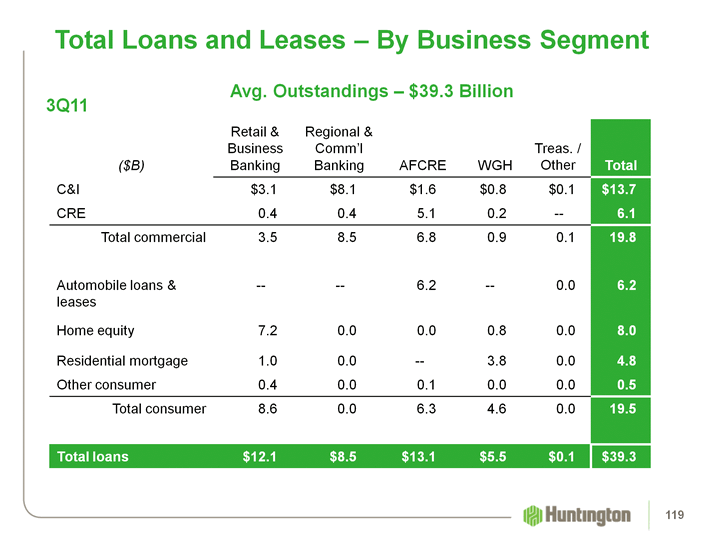
| Total Loans and Leases - By Business Segment Total Loans and Leases - By Business Segment Avg. Outstandings - $39.3 Billion 3Q11 119 |

| Total Deposits - By Business Segment Total Deposits - By Business Segment Avg. Balances - $42.3 Billion 3Q11 120 |
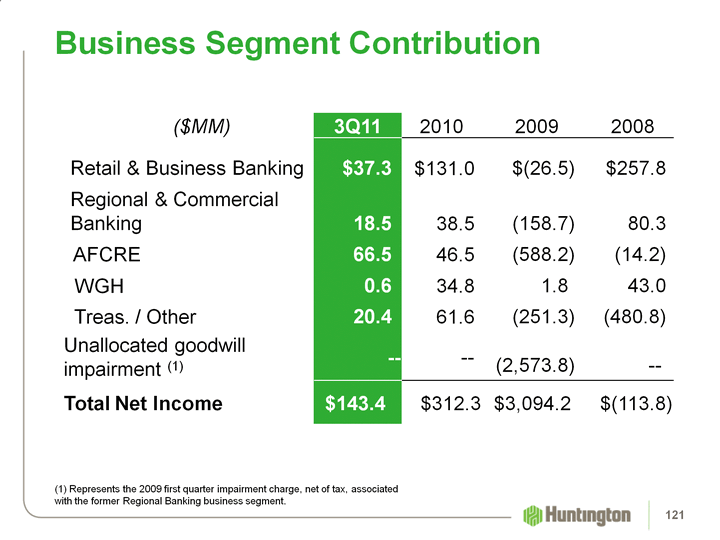
| Business Segment Contribution ($MM) 3Q11 2010 2009 2008 Retail & Business Banking $37.3 $131.0 $(26.5) $257.8 Regional & Commercial Banking 18.5 38.5 (158.7) 80.3 AFCRE 66.5 46.5 (588.2) (14.2) WGH 0.6 34.8 1.8 43.0 Treas. / Other 20.4 61.6 (251.3) (480.8) Unallocated goodwill impairment (1) -- -- (2,573.8) -- Total Net Income $143.4 $312.3 $3,094.2 $(113.8) (1) Represents the 2009 first quarter impairment charge, net of tax, associated with the former Regional Banking business segment. 121 |

| Business Segment Overview Regional & Commercial Banking Executive - Jim Dunlap 11 Region Presidents Middle Market Commercial Banking Specialty Banking Large Corporate Health-care Not-for-Profit Equipment Finance International Services Treasury Management Capital Markets Derivatives Foreign Exchange Securities Trading Retail & Business Banking Executive - Mary Navarro Branch Sales and Service 5 Retail Banking Areas Consumer Banking Business Banking In-Store Branches Deposit Product Pricing and Fees Marketing and Customer Experience Payments and Channels 122 |
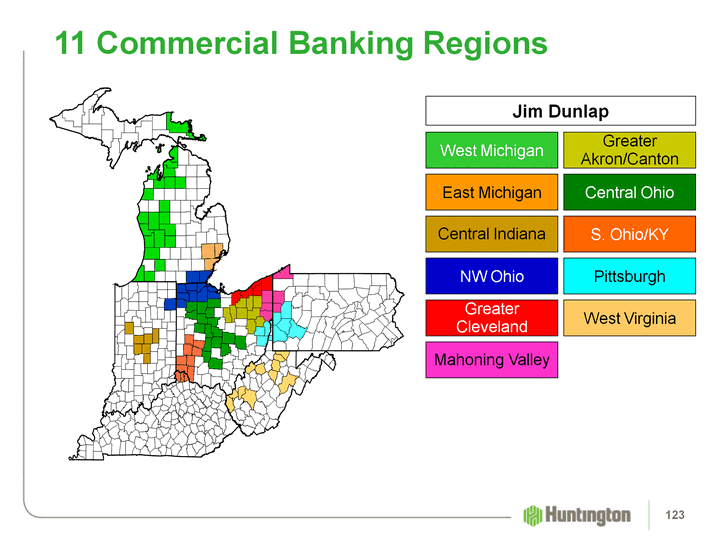
| 11 Commercial Banking Regions Greater Akron/Canton Mahoning Valley Central Ohio NW Ohio S. Ohio/KY Greater Cleveland Central Indiana West Michigan East Michigan West Virginia Pittsburgh Jim Dunlap 123 |

| Regional Banking Presidents 124 |
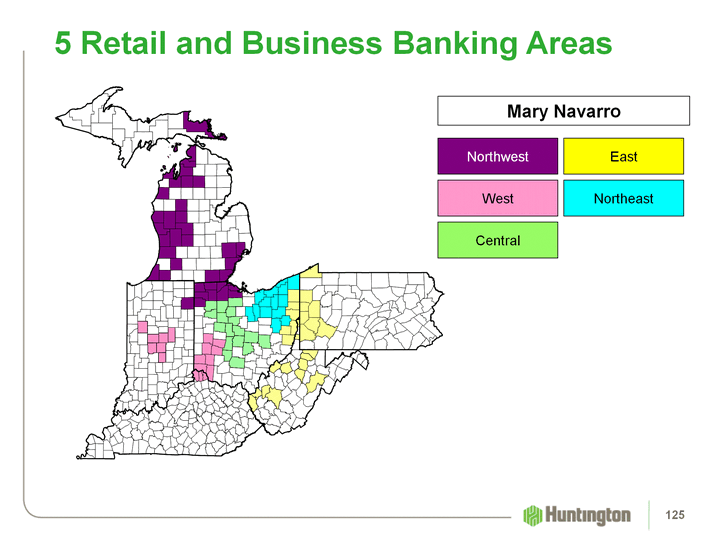
| 5 Retail and Business Banking Areas Central Northwest West Northeast East Mary Navarro 125 |
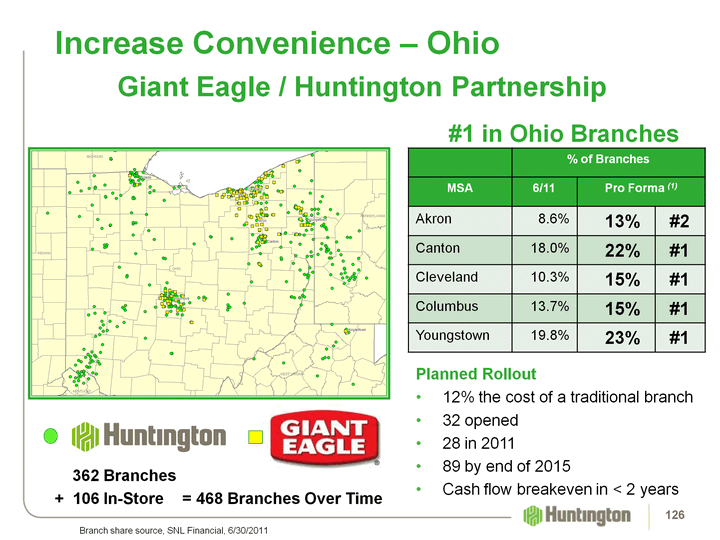
| #1 in Ohio Branches Planned Rollout 12% the cost of a traditional branch 32 opened 28 in 2011 89 by end of 2015 Cash flow breakeven in < 2 years Increase Convenience - Ohio Branch share source, SNL Financial, 6/30/2011 % of Branches % of Branches % of Branches MSA 6/11 Pro Forma (1) Pro Forma (1) Akron 8.6% 13% #2 Canton 18.0% 22% #1 Cleveland 10.3% 15% #1 Columbus 13.7% 15% #1 Youngstown 19.8% 23% #1 362 Branches + 106 In-Store = 468 Branches Over Time Giant Eagle / Huntington Partnership 126 126 |
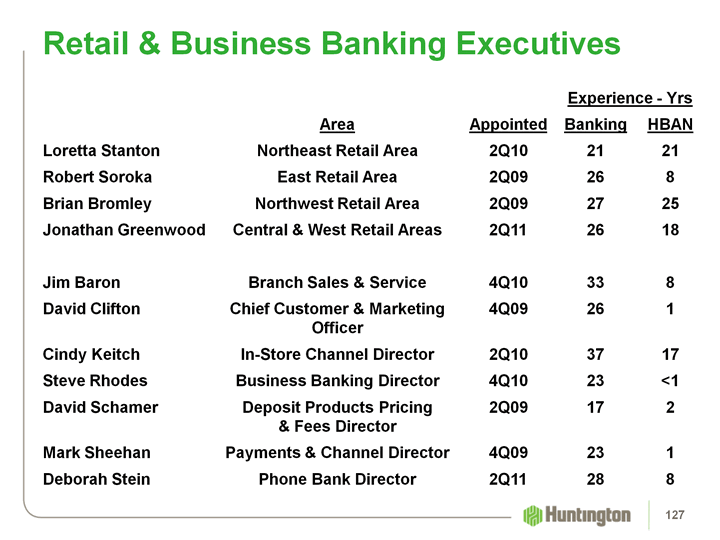
| Retail & Business Banking Executives 127 |
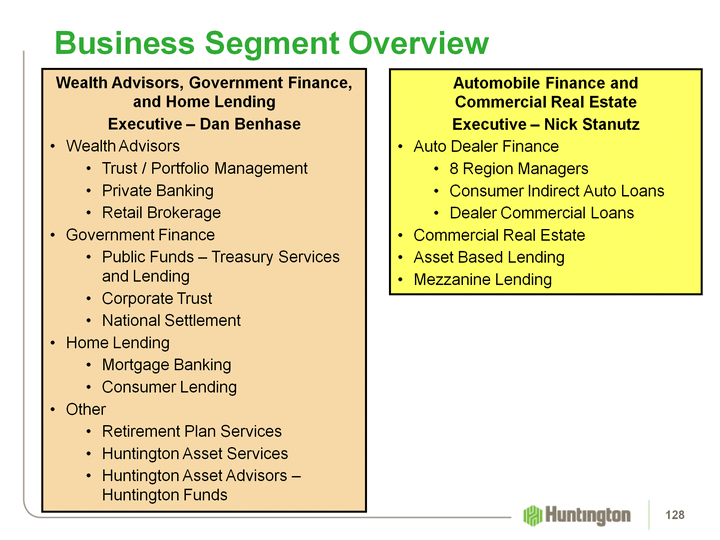
| Business Segment Overview Wealth Advisors, Government Finance, and Home Lending Executive - Dan Benhase Wealth Advisors Trust / Portfolio Management Private Banking Retail Brokerage Government Finance Public Funds - Treasury Services and Lending Corporate Trust National Settlement Home Lending Mortgage Banking Consumer Lending Other Retirement Plan Services Huntington Asset Services Huntington Asset Advisors - Huntington Funds Automobile Finance and Commercial Real Estate Executive - Nick Stanutz Auto Dealer Finance 8 Region Managers Consumer Indirect Auto Loans Dealer Commercial Loans Commercial Real Estate Asset Based Lending Mezzanine Lending 128 |
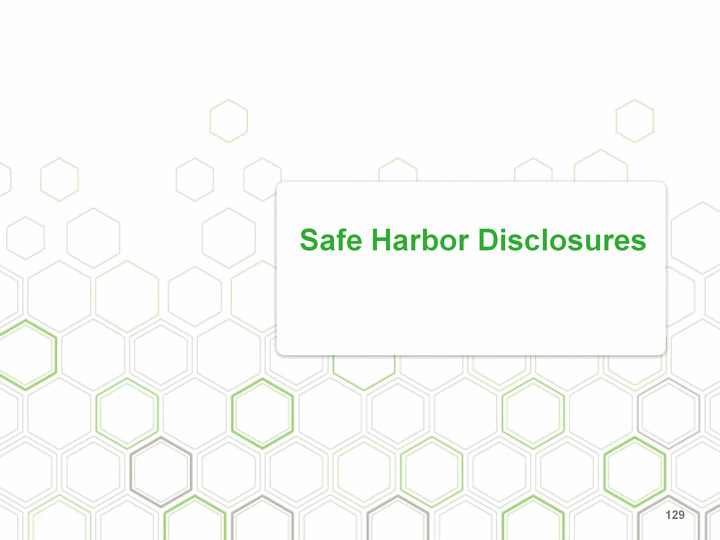
| Safe Harbor Disclosures 129 |
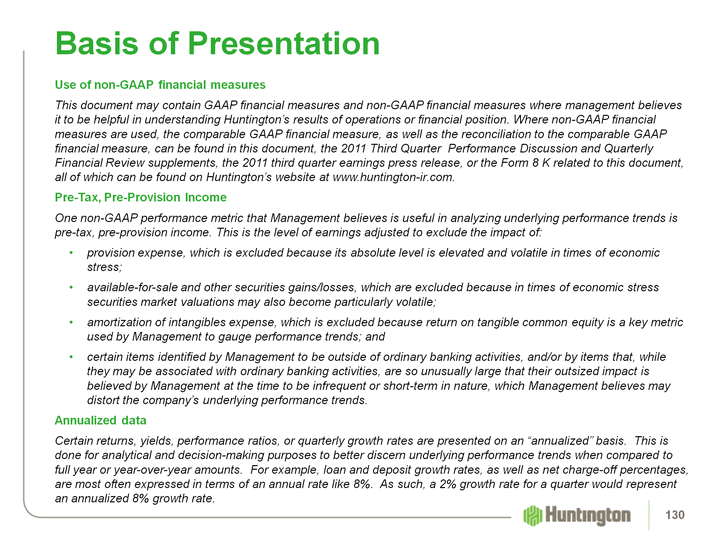
| Use of non-GAAP financial measures This document may contain GAAP financial measures and non-GAAP financial measures where management believes it to be helpful in understanding Huntington's results of operations or financial position. Where non-GAAP financial measures are used, the comparable GAAP financial measure, as well as the reconciliation to the comparable GAAP financial measure, can be found in this document, the 2011 Third Quarter Performance Discussion and Quarterly Financial Review supplements, the 2011 third quarter earnings press release, or the Form 8 K related to this document, all of which can be found on Huntington's website at www.huntington-ir.com. Pre-Tax, Pre-Provision Income One non-GAAP performance metric that Management believes is useful in analyzing underlying performance trends is pre-tax, pre-provision income. This is the level of earnings adjusted to exclude the impact of: provision expense, which is excluded because its absolute level is elevated and volatile in times of economic stress; available-for-sale and other securities gains/losses, which are excluded because in times of economic stress securities market valuations may also become particularly volatile; amortization of intangibles expense, which is excluded because return on tangible common equity is a key metric used by Management to gauge performance trends; and certain items identified by Management to be outside of ordinary banking activities, and/or by items that, while they may be associated with ordinary banking activities, are so unusually large that their outsized impact is believed by Management at the time to be infrequent or short-term in nature, which Management believes may distort the company's underlying performance trends. Annualized data Certain returns, yields, performance ratios, or quarterly growth rates are presented on an "annualized" basis. This is done for analytical and decision-making purposes to better discern underlying performance trends when compared to full year or year-over-year amounts. For example, loan and deposit growth rates, as well as net charge-off percentages, are most often expressed in terms of an annual rate like 8%. As such, a 2% growth rate for a quarter would represent an annualized 8% growth rate. Basis of Presentation 130 |
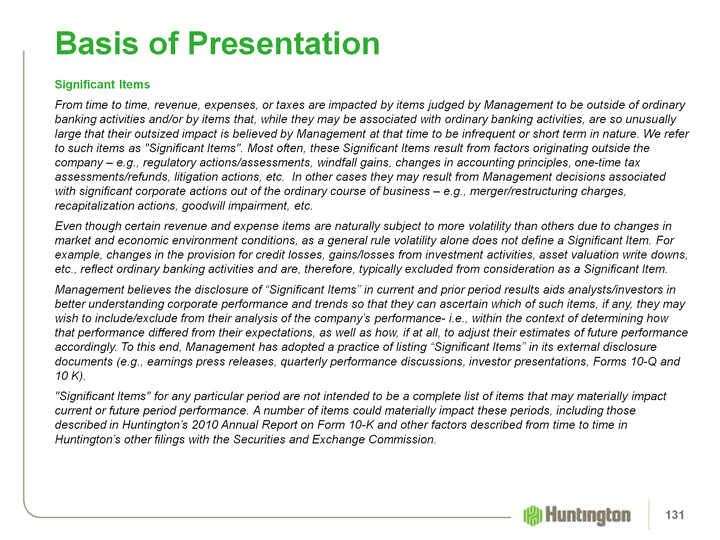
| Significant Items From time to time, revenue, expenses, or taxes are impacted by items judged by Management to be outside of ordinary banking activities and/or by items that, while they may be associated with ordinary banking activities, are so unusually large that their outsized impact is believed by Management at that time to be infrequent or short term in nature. We refer to such items as "Significant Items". Most often, these Significant Items result from factors originating outside the company - e.g., regulatory actions/assessments, windfall gains, changes in accounting principles, one-time tax assessments/refunds, litigation actions, etc. In other cases they may result from Management decisions associated with significant corporate actions out of the ordinary course of business - e.g., merger/restructuring charges, recapitalization actions, goodwill impairment, etc. Even though certain revenue and expense items are naturally subject to more volatility than others due to changes in market and economic environment conditions, as a general rule volatility alone does not define a Significant Item. For example, changes in the provision for credit losses, gains/losses from investment activities, asset valuation write downs, etc., reflect ordinary banking activities and are, therefore, typically excluded from consideration as a Significant Item. Management believes the disclosure of "Significant Items" in current and prior period results aids analysts/investors in better understanding corporate performance and trends so that they can ascertain which of such items, if any, they may wish to include/exclude from their analysis of the company's performance- i.e., within the context of determining how that performance differed from their expectations, as well as how, if at all, to adjust their estimates of future performance accordingly. To this end, Management has adopted a practice of listing "Significant Items" in its external disclosure documents (e.g., earnings press releases, quarterly performance discussions, investor presentations, Forms 10-Q and 10 K). "Significant Items" for any particular period are not intended to be a complete list of items that may materially impact current or future period performance. A number of items could materially impact these periods, including those described in Huntington's 2010 Annual Report on Form 10-K and other factors described from time to time in Huntington's other filings with the Securities and Exchange Commission. Basis of Presentation 131 |
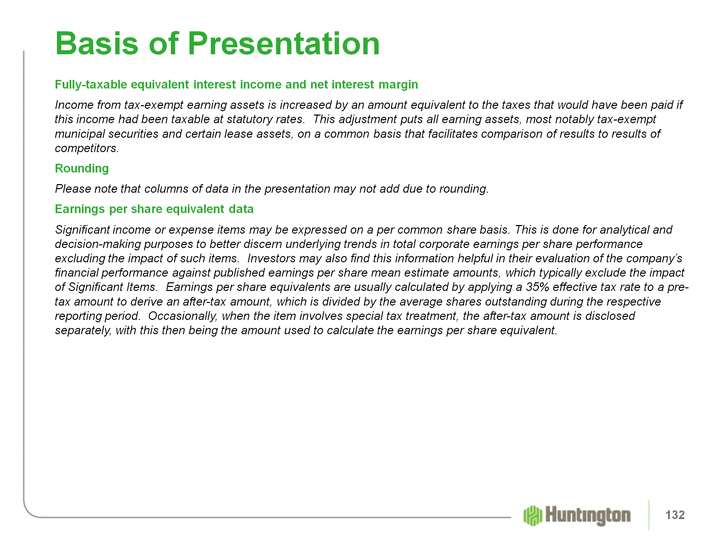
| Fully-taxable equivalent interest income and net interest margin Income from tax-exempt earning assets is increased by an amount equivalent to the taxes that would have been paid if this income had been taxable at statutory rates. This adjustment puts all earning assets, most notably tax-exempt municipal securities and certain lease assets, on a common basis that facilitates comparison of results to results of competitors. Rounding Please note that columns of data in the presentation may not add due to rounding. Earnings per share equivalent data Significant income or expense items may be expressed on a per common share basis. This is done for analytical and decision-making purposes to better discern underlying trends in total corporate earnings per share performance excluding the impact of such items. Investors may also find this information helpful in their evaluation of the company's financial performance against published earnings per share mean estimate amounts, which typically exclude the impact of Significant Items. Earnings per share equivalents are usually calculated by applying a 35% effective tax rate to a pre- tax amount to derive an after-tax amount, which is divided by the average shares outstanding during the respective reporting period. Occasionally, when the item involves special tax treatment, the after-tax amount is disclosed separately, with this then being the amount used to calculate the earnings per share equivalent. Basis of Presentation 132 |
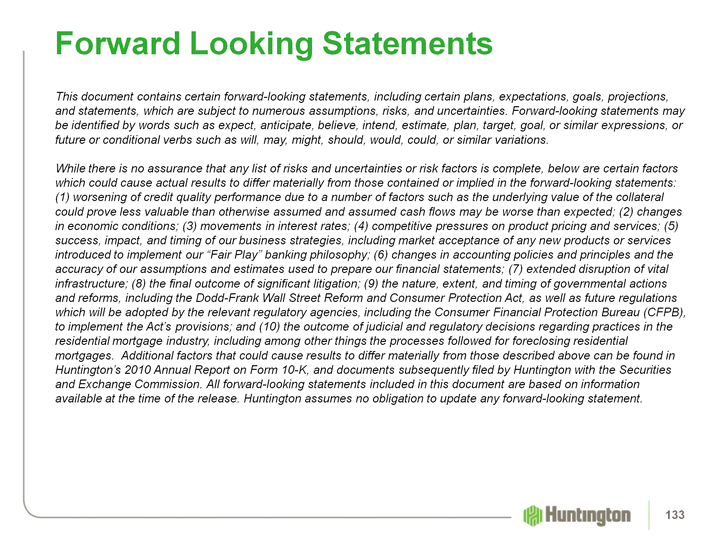
| This document contains certain forward-looking statements, including certain plans, expectations, goals, projections, and statements, which are subject to numerous assumptions, risks, and uncertainties. Forward-looking statements may be identified by words such as expect, anticipate, believe, intend, estimate, plan, target, goal, or similar expressions, or future or conditional verbs such as will, may, might, should, would, could, or similar variations. While there is no assurance that any list of risks and uncertainties or risk factors is complete, below are certain factors which could cause actual results to differ materially from those contained or implied in the forward-looking statements: (1) worsening of credit quality performance due to a number of factors such as the underlying value of the collateral could prove less valuable than otherwise assumed and assumed cash flows may be worse than expected; (2) changes in economic conditions; (3) movements in interest rates; (4) competitive pressures on product pricing and services; (5) success, impact, and timing of our business strategies, including market acceptance of any new products or services introduced to implement our "Fair Play" banking philosophy; (6) changes in accounting policies and principles and the accuracy of our assumptions and estimates used to prepare our financial statements; (7) extended disruption of vital infrastructure; (8) the final outcome of significant litigation; (9) the nature, extent, and timing of governmental actions and reforms, including the Dodd-Frank Wall Street Reform and Consumer Protection Act, as well as future regulations which will be adopted by the relevant regulatory agencies, including the Consumer Financial Protection Bureau (CFPB), to implement the Act's provisions; and (10) the outcome of judicial and regulatory decisions regarding practices in the residential mortgage industry, including among other things the processes followed for foreclosing residential mortgages. Additional factors that could cause results to differ materially from those described above can be found in Huntington's 2010 Annual Report on Form 10-K, and documents subsequently filed by Huntington with the Securities and Exchange Commission. All forward-looking statements included in this document are based on information available at the time of the release. Huntington assumes no obligation to update any forward-looking statement. Forward Looking Statements 133 |